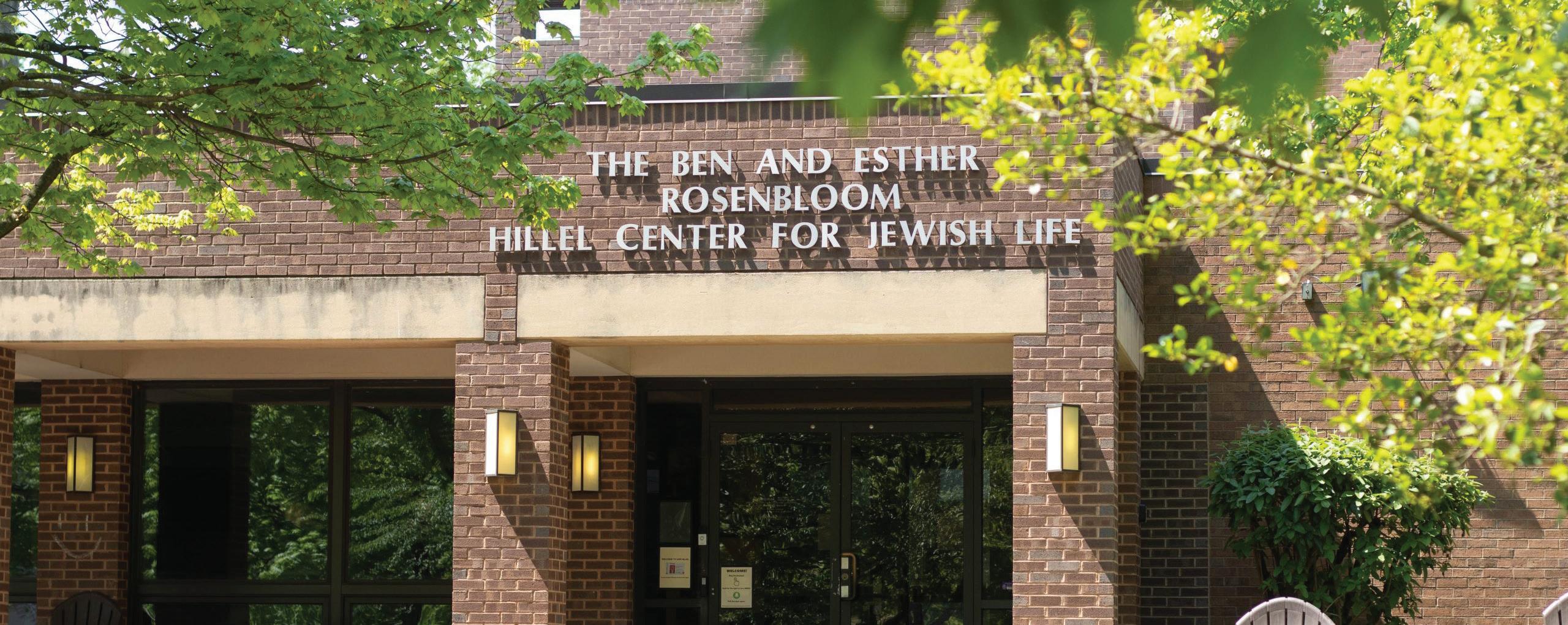The


The

23- Traducción - Ayuda Financiera
Guía detallada sobre ayuda nanciera universitaria
24- Hungry Terps
On-campus places to eat instead of the dining hall
25- UMD Traditions Cartoon
Important resources for life in College Park
Terrapin Transport
UMD has a big campus, here’s how to get around
Panera Opening
STAMP Panera nally opens
Chemistry Building
UMD unveils $132 million new chemistry building
13- Construction Updates
Updates on current projects on campus 14- Diamondback Jobs Guide
Check out our guide to student wages & campus jobs
15- SGA Roundup
A look at UMD SGA’s accomplishments this year
16- Campus Map
Here’s a look at campus and College Park
18- RHA Roundup
Here are some of the bills UMD RHA passed this year
19- New Business Roundup
A look at the College Park business scene in 2024
20- Computer Science Transfer Admissions
CS transfer admissions set to decrease by 90 percent
21- The Game Day Experience
Make the most out of your trip to the stadium
22- Understanding Financial Aid
Detailed guide on college nancial aid
Founded 1910, independent since 1971.
APURVA
MAHAJAN Editor in chief
3150 S. Campus Dining Hall, College Park, Md., 20742 (301) 314-8200
https://dbknews.com/contact-us/
THE DIAMONDBACK:
FULLY UPDATED AND EDITED BY:
Nur Yavuz
Adam Hudacek
ADVERTISING:
ads@dbknews.com (301) 276-5770
Job openings: https://dbknews.com/jobs/ Newsletter: https://ter.ps/DBKNL
ORIGINAL TEXT BY:
Monica Godnick
Irit Skulnik
Lillian Glaros
Christine Zhu
Ava Wallace
Katharine Wilson
Emely Miranda
Amanda Hernández
Sofia Appolonio
Olivia Borgula
Fiona Roy
Ava Wallace illustrate staples of UMD culture
26- Survivor Maryland e new community of UMD Survior
27- Sports Roundup
A recap of the 2023-24 UMD sports seasons
28- Rental Subsidy in College Park
City Council approves rent subsidy pilot program
29- UMD Handbook
Lessons for students from the 1924 handbook
30- New RHA President
New RHA o cers share priorities for next year
31- Out of State Advice
Advice on how to acclimate to a new state
32- Majors with Enrollment Increases
10 majors which have seen at least a 20% increase
35- Terp Trivia
Seventeen fun facts about UMD
36- WMUC Turns 75
UMD radio station celebrates 75 years on air
37- Shop Made Comes to College Park
Classes, co ee and community
38- Halal Dining on Campus
Muslim students praise new halal station at 251 North
39- Kosher Dining Hall Option
Dining Services look to expand kosher dining on campus
COPY EDITED BY:
Apurva Mahajan
Lizzy Alspach
Olivia Borgula
Chelsea Collier
Zachary Intrater
DESIGNED BY:
Sydney Theis
Rebecca Safra
PHOTO EDITING BY:
Neelay Sachdeva
FRONT COVER PHOTO BY: Sam Cohen
Sumaya Abdel-Motagaly
Sam Gauntt
Matt Kau man
Eden Binder
Katherine Mahoney
Adam Hudacek
Eli Cohen


Dear reader,
Welcome to the University of Maryland! We hope you recognize all the hard work it took to get here. Whether you are a freshman or a transfer student, consider this a guide to this university as you dive into life in College Park. This guide has a plethora of information that we hope will make these new, overwhelming moments a little easier. From Metro rides into Washington, D.C., to cheering for sports events year-round to laying on McKeldin Mall while the sun sets, it’s the little things that make this university feel like home. There might be nerve-wracking moments while getting used to your classes and meeting new people, we’ve all been there. Be patient with yourself. You got this. The immense number of clubs, advocacy groups and Greek life organizations make our huge campus feel like a tight-knit community. Don’t forget to stop and enjoy this time while it lasts. The semesters will speed by faster than you think.
Best of luck, Terps. To new beginnings!
- Monica Godnick



Visit the official UMD Academic Calendar for more information at academiccatalog.umd.edu/about-university/academic-calendar/semester-calendar!
Aug. 26 — First day of classes
Sept. 2 — Labor Day
Nov. 27-Dec.1 — Thanksgiving break
Dec. 9 — Last day of classes
Dec. 10 — Reading day
Dec. 11-17 — Final exams
See commencement.umd.edu for any updates
Jan. 27 — First Day of Classes
March 16-23 — Spring Break
May 13 — Last day of classes
May 14 — Reading day
May 15-21 — Final exams
May 21 — Commencement (college/department ceremonies)
May 22 — Commencement (main ceremony)
May 23 — Commencement (college/department ceremonies)
Jan. 2 — Classes begin
Jan. 20 — Dr. Martin Luther King Jr.
Holiday
Jan. 22 — Classes end
June 2 — Sessions I and I-A begin
June 19 — Juneteenth Holiday
June 20 — Session I-A ends
June 23 — Session I-B begins
July 4 — Independence Day holiday
July 11 — Sessions I and I-B end
July 14 — Sessions II and II-C begin
Aug. 1 — Session II-C ends
Aug. 4 — Session II-D begins
Aug. 22 — Sessions II and II-D end

There are plenty of resources available to help you take the extra steps to stay safe in College Park.
Emergency: 911 or 301-405-3333
College Park doesn’t have a police department, so the University of Maryland Police help patrol the city as well as the campus. Give them a call if there’s a crime, an emergency or if you have something urgent to report.
Non-emergency: 301-405-3555
The police escort service is available to anyone who feels unsafe at any time. Police o cers and student members of the police auxiliary service will walk with you across campus. Call the non-emergency police number to access this.
The Counseling Center: 301-314-7651
Counselors are available for therapy sessions, and the center provides psychological evaluations and consultations. Students are limited to eight individual sessions per 12-month period. The center also provides wellness workshops and group counseling as well.
Health Center’s Behavioral Health Services: 301-314-8106
Psychiatrists, psychiatric nurse practitioners and psychotherapists can meet with students to o er them psychiatric evaluation or care. The center can also connect you to another psychiatric provider outside the university.
CARE to Stop Violence: 301-314-2222
24-hour hotline: 301-741-3442
Campus Advocates Respond and Educate to Stop Violence educates students about domestic and sexual violence and works with victims. CARE can help with everything from counseling and advice to providing educational workshops for you to learn more about responding to violence.
Blue Light emergency phones are located all over the campus. They provide a direct connection to the University of Maryland Police Department and can be used during emergencies at any time.
NITE Ride: 301-314-3687
If you don’t feel safe out at night, NITE Ride can pick you up and take you anywhere on campus free of charge. From 5:30 p.m. to 2:30 a.m., it runs only to designated locations on campus. From 2:30 to 7:30 a.m., it picks up and drops o to areas of campus that are not covered by Shuttle UM. The service is provided by the Department of Transportation seven nights per week.
UMD Alerts are sent out when there’s a report of an emergency or a crime on or near the campus. The alerts will also cover weather-related closings and other situations that impact the university community.
As a student, you’re automatically signed up to get UMD Alerts through your email. If you prefer text messages, you can register for that by adding your phone number at alert.umd.edu.
This article is part of The Diamondback’s 2020 Orientation Guide. Some information and resources have been updated to reflect current dates and events.




The Hotel at the University of Maryland is a AAA Four-Diamond hotel that combines beautiful accommodations with exceptional amenities. Located across the street from the university’s main campus entrance, The Hotel is the perfect location for Terrapins — from families sending their students off to school or celebrating their graduation to fans heading to the big game.
▪ 297 guest rooms with one king or two queen beds
▪ Mini coolers, illy coffee machines, complimentary Wi-Fi and personal safes in every room
▪ Indoor swimming pool and wellness area
▪ Fully equipped fitness center
GrillMarX offers you a casual, upscale dining experience, serving hickory-grilled, hand-cut steaks, a variety of fresh seafood and uniquely crafted cocktails.
▪ The Spa, College Park's only boutique spa, offering massages, facials, nails and waxing
▪ Hair + Space, a premier blowdry and beauty bar, offering a wide range of salon services
Bagels ’n Grinds, home to the area’s best New York bagels made on site every morning, offers quick, made-to-order breakfast and lunch.
▪ The Lobby Bar and four unique restaurants
▪ Overnight parking available in our gated garage
▪ Complimentary shuttle service to Metro, campus and local destinations within a three-mile radius
Potomac Pizza offers fresh, delicious traditional and specialty pizzas, sandwiches, classic Italian dishes, salads and more.
At Iron Rooster, where the chicken is fried and the biscuits come with gravy, you can enjoy all-day breakfast, lunch or supper.
The Hotel at the University of Maryland | 7777 Baltimore Avenue, College Park, MD 20740 301.277.7777 | TheHotelUMD.com
Updated by Nur Yavuz I Tabloid editor
The University of Maryland’s campus is pretty walkable, but sometimes you need to leave College Park — or maybe you just don’t feel like traveling on foot after a long day of classes. Here are some alternative ways to get around.
1
Department of Transportation Services has one of the most expansive shuttle bus systems in the nation, with more than 20 routes. Not only can these buses take you all around campus, but they also go anywhere from Varsity and University View apartments to Hyattsville and Silver Spring.
Most on-campus buses run several times an hour after 5:30 p.m., with o -campus bus schedules varying. You can see bus maps and times on dots with the Transit app.
3
Biking is a great way to get across campus when you want. You can use your own bike on campus if you register it with DOTS (it’s free!) at bikeindex.org/umd.edu. Be careful not to break the rules, though — don’t bike on the sidewalk and don’t leave your bike on a rack for more than 72 hours.
2
Although College Park has a lot to o er, sometimes you just need to go to Washington, D.C. Luckily, getting there is easy. The #104 bus will take you to the College Park Metro station. The station is also both walkable and bikeable from campus. Once you get to the Metro, you’re just a quick ride away from the National Zoo, the Smithsonian museums, the National Mall and more.
4
College Park, in partnership with VeoRide, debuted a scooter and bike-share program. The program brought electric scooters, as well as both electric and regular bikes, to campus.
Through the VeoRide app, you can unlock a device and start riding. To rent, you’ll have to pay an unlock fee, plus a fee per minute. The price depends on what kind of device you choose to hop on.
Renting a scooter or bike is a big help if you’ve got class on the other side of campus or you don’t have the time to wait for a bus. Just make sure you ride safely and responsibly. Stick to the roads and stay o the sidewalk.
5
If you own a private e-bike or e-scooter, you’ll have to register it with DOTS.
When you need a longer-term rental, Zipcars are another option. Members can rent vehicles by the hour or by the day. Once you register through the app, you can access Zipcars all around the country, not just in College Park. Drive, but beware of parking.
Parking can be a bit tricky. All students are eligible to register for on-campus parking, and registration dates vary on a rolling basis according to credit level starting at the end of July.
Registration isn’t cheap, either. For the 2022-2023 academic year, annual parking permits were $701 for resident students and $362 for commuter students. There are numerous lots and garages on campus, each with their own rules and restrictions. If you get a permit, you’ll want to make sure you’re parking in the right place, or else you risk getting a ticket.
Many parking lots may close with all of the construction going on, so be sure to check the DOTS website and The Diamondback for updates.
This article is part of The Diamondback’s 2020 Orientation Guide. Some information and resources have been updated to reflect current dates and events.
By Irit Skulnik I Sta writer
The Panera Bread at Stamp Student Union opened May 2 after more than a year of delays.
The fast-casual restaurant, which was originally scheduled to open in fall 2022, is now open for customers on the first floor of Stamp in the space previously occupied by Adele’s restaurant.
Panera was most recently scheduled to open May 1 but equipment issues led to the opening being pushed back another day, according to Dining Services spokesperson Bart Hipple. While preparing for the opening earlier this week, sta discovered some of the equipment — including an oven and co ee maker — were not working properly, Hipple told The Diamondback.
“We had some equipment issues,” Hipple said. “Our maintenance crew and the Stamp team all got together and worked things out and got it working properly, and we’re open and serving. It looks beautiful in there.”
According to Hipple, the restaurant had already served 65 customers by 9 a.m.
Freshman Caitlyn Kelly got to Panera
early to try to avoid a long wait time, she said. She used the self-order kiosks which she said was “really easy” and got her food about 10 minutes later.
Kelly, who is enrolled in letters and sciences, said she had “slight doubts” that Panera would actually open today because of the numerous delays.
Delays over the past two years have been due to challenges with equipment sourcing, permits and other operational issues, The Diamondback previously reported.
Construction delays partially stemmed from di culties in obtaining certain pieces of equipment, such as large ovens, after the COVID-19 pandemic, Stamp director Marsha Guenzler-Stevens told The Diamondback in February.
Sophomore Erin Kaczor also doubted that Panera would open May 2.
“I had no hope that it was going to open today at all,” the public health major said. “I was like, ‘This is just a hoax. It’s never gonna open.’”
She said she was happy when she saw it
open May 2 and appreciated the restaurant’s quick service during her visit.
By noon on May 2, a line had developed outside Panera to enter the restaurant and order.
According to Hipple, other Panera “experts” from di erent locations and additional Dining Services sta members are on standby to help out.
“[They’re] ready to hop in and make sure things come out as quickly as they can,” Hipple said.
Junior elementary education major Lili Adolph arrived at Panera at 11:15 a.m. and waited more than 15 minutes to get inside the restaurant, she said. Adolph said she thought it would be worth the wait though.
“I’m really excited. I love Panera and I’m glad that it’s here,” Adolph said.
The restaurant will be open from 7:30 a.m. to 8 p.m. Monday through Friday and 11:30 a.m. to 4 p.m. on Saturday and Sunday, according to Dining Services’ website.
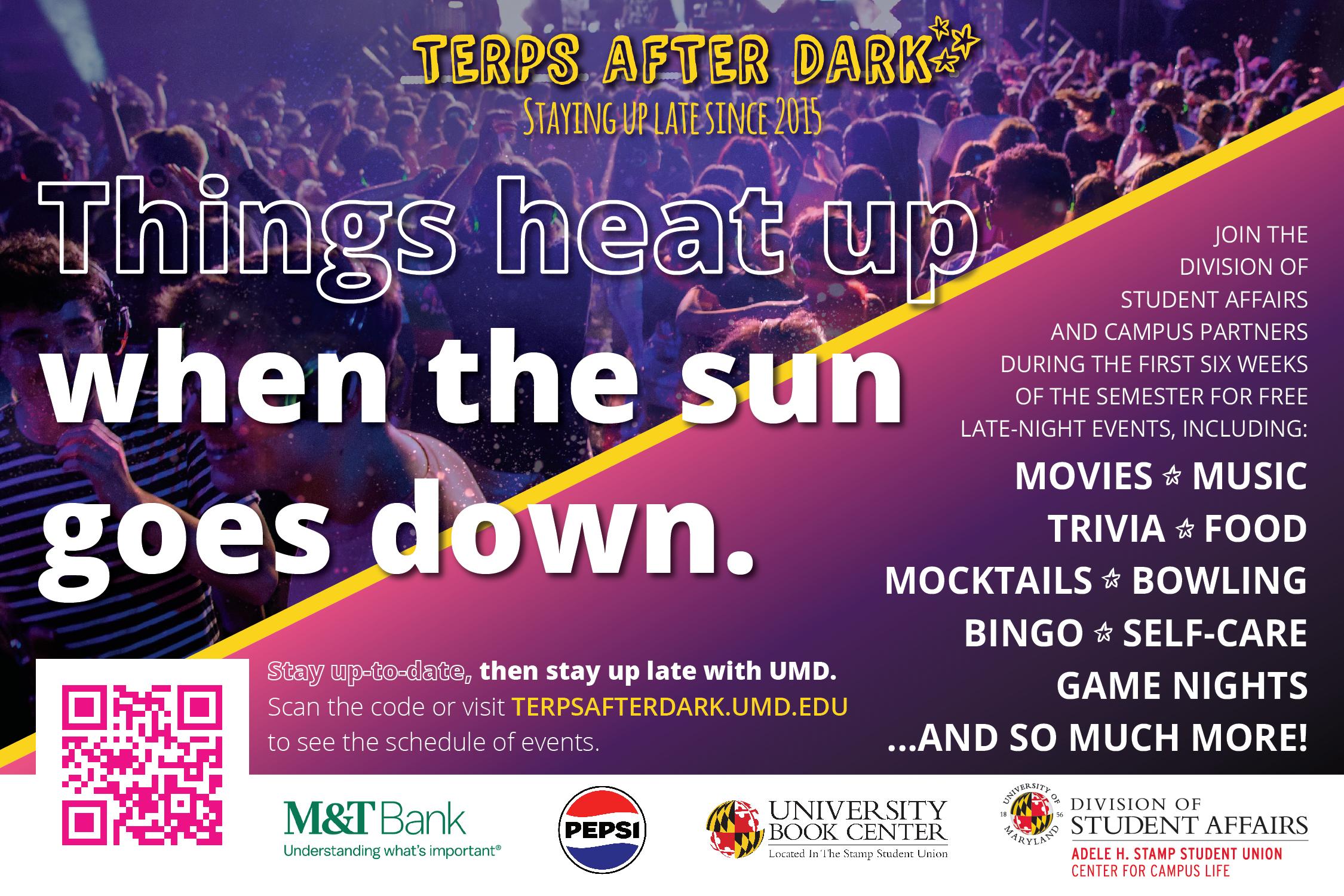
University of Maryland community members gathered on April 11 for the new chemistry building’s dedication. The $132 million project is geared toward combining quantum chemistry, molecular nanoscience and sustainability research.
The 105,000-square-foot facility has 34 labs, according to a news release. It took about three years to construct and replace the old chemistry building’s wing 1, which was demolished ahead of the modernized space’s groundbreaking in August 2021.
The new building is located on Chemistry Lane and is adjacent to many engineering buildings.
Speakers at the event detailed how the building marks an investment in the department’s faculty, sta and students.
“This new paradigm will provide our students and faculty members with the tools and technologies they need to take their discoveries and innovations to the next level,” Amitabh Varshney, the computer, mathematical and natural sciences college’s dean, said. “All of these advances will improve our world and drive our economy.”
University president Darryll Pines emphasized how the chemistry department now has more opportunities for innovation.
By Christine Zhu I DBKenEspañoleditor
This university has produced Nobel Prize laureates and Rhodes scholars, and Pines said he wants that number to increase.
Pines is optimistic about the discoveries that will occur in the building. Along with breakthroughs in quantum materials chemistry and developing artificial intelligence to pinpoint candidates for drug development, he hopes to solidify the department’s place in the academic world.
“I dream one day that the next element in the periodic table will be discovered here,” Pines said.
The structure houses two shared research facilities with cutting-edge instruments as well as 13,000 square feet of collaboration space, according to a university news release. A 2,300-square-foot conference room with a high-definition screen o ers a space for chemistry department faculty and students to participate in lectures, conferences and celebrations.
The building also features 12 meeting and huddle rooms where students can study, meet for group projects and defend theses. Notable research projects for the new building include an HIV vaccine, energy and sustainability technologies and detecting ovarian cancer from blood samples,
according to the news release.
Maryland House Speaker Adrienne Jones said at the dedication event that the state legislature is dedicated to investing in transformative spaces on this university’s campus. She welcomes this university’s commitment towards the industry’s future, including in terms of diversity, she said.
“We are proud to see the University of Maryland focused on increasing the number of women in STEM fields and looking forward to seeing an ever-increasing number of women chemists,” Jones said. “We are proud this building will train the next generation of our nation’s top scientists.”
Jones presented Pines with a citation from the Maryland General Assembly to honor the occasion.
Janice Reutt-Robey, the chemistry and biochemistry department’s chair, said chemistry is known as the central science for its role in connecting the physical sciences, life sciences and engineering. It’s fitting for the building’s spot on campus.
“The location of this building is a hub between engineering, physics and biological sciences departments, representing the central role that we play at the university,” Reutt-Robey said.

By Lillian Glaros I Sta Writer
The University of Maryland has several in-progress construction projects on campus. The projects include the Purple Line, which will run through this university and bridge New Carrollton with parts of Montgomery County, and new academic buildings. Here’s a look at some of the current construction projects on campus.
Most of this university’s Purple Line construction will likely be completed by fall 2024, university president Darryll Pines told The Diamondback Wednesday.
“Over the last couple of months, we’ve been fortunate to work with the state to accelerate the construction of the Purple Line through the center of campus,” Pines said.
While the line is scheduled to start carrying passengers in December 2027, most of its construction on campus was expected to be completed by 2025, according to this university’s administration division website.
The light rail project would connect this university to Washington, D.C. and Maryland suburbs. Five of the light rail’s 21 stops will be on this university’s campus.
Construction for the project has caused road and sidewalk closures across Campus Drive for the past few years.
Memoona Munir, a senior biology major, said that while the construction has posed an “inconvenience” for many students, it will ultimately benefit the campus community.
“It’s going to be really convenient for students that go here,” Munir said. “The end result is going to be worth it.”
Construction in the Cole Head House will add five new cultural centers to this university.
The cultural centers will be for the Latinx, Native American and Indigenous, multiracial and biracial, Asian, Pacific Islander and Desi American communities along with students with disabilities, The Diamondback previously reported.
Demolition inside the facility is “essentially complete” and construction is currently in progress, according to a statement by Facilities Management.
The $22 million project is expected to be substantially completed by May 2025.
The new performance center, located next to Xfinity Center, will be the first dedicated basketball practice facility for the men’s and women’s teams, The Diamondback previously reported.
Underground utility installation is in progress and the center’s concrete foundations are nearing completion, according to Facilities Management.
The $52 million project is scheduled to be substantially completed by June 2025.
The new academic building will provide new space for the mechanical and civil engineering department.
Construction for the $214 million project began in January 2023 and is estimated to be substantially completed by May 2026.
Installation of underground utilities and concrete structures is in progress, the Facilities Management statement said.
The $150,000 project will replace one of Paint Branch Drive’s lanes with a dedicated bike pathway, Facilities Management said in a statement to The Diamondback.
Construction for the project is expected to begin in July and be substantially completed in August.
CLARIFICATION: This story and its headline have been updated to better reflect that most of this university’s Purple Line construction will be completed by fall 2024, which was originally scheduled to be completed in 2025.
Diamondback Sta
The Diamondback has been an almost entirely online publication since March 2020. Since then, we’ve been exploring new ways to engage readers and address the information needs of the university community in the digital space.
Initially, that looked like launching a COVID-19 dashboard and publishing case counts when the university stopped publicly reporting them. From the reception we received, one thing is clear: Our audience craves accountability and transparency in the community. That’s why in 2023, we introduced The Diamondback jobs guide, a site that empowers users to explore historic student wages and discover campus jobs. The jobs guide is designed to help students make informed decisions while looking for employment around the campus. Drawing inspiration from The Diamondback salary guide, the jobs guide empowers users to explore the data independently.
Sometimes, what worked in the past can be reimagined for the present. In print newspapers, including historical editions of The Diamondback, the classified section was an avenue to communicate local opportunities. We envision our jobs guide serving a similar purpose for the University of Maryland community.
With the jobs guide and future reporting, The Diamondback seeks to be data-driven in its approach to service the broader University of Maryland community. Thank you to the readers, students, focus group members and Diamondback sta for driving this mission forward.
Explore The Diamondback jobs guide at jobs.dbknews.com.This guide was made possible by Nataraj Shivaprasad,Rina Torchinsky and Sri Kanipakala.








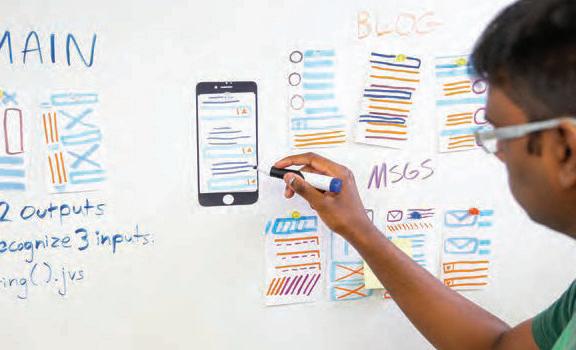







By Lillian Glaros I Sta writer
The University of Maryland SGA worked on many projects this past school year, focusing on issues such as student fees, food options in dining halls, mental health and more. Here are some of the Student Government Association’s main accomplishments this year.
In the 2024 election ballot, the SGA included a referendum asking students about increasing the student activities fee. After a majority vote in favor of raising the fee, the SGA increased student fees by $3 and $6, for part-time and fulltime students, respectively.
This fee will help the SGA avoid cutting the budget for student group funding in the future, The Diamondback previously reported.
“We’ve been working o of a COVID surplus from when there weren’t many student activities taking place on campus,” Eliav Hamburger, the former speaker and a junior computer engineering major, said. “That coupled with inflation has essentially wiped out all of our student activities fee reserves.”
The SGA has advocated to increase kosher and halal dining options on campus, according to Evren Yucekus-Kissane, the former chief of sta and a junior computer science major.
The SGA worked to allow Hillel dining plans to include dining dollars. The organization is also advocating for a kosher kitchen in one of the dining halls to increase access for Jewish students.
About 19 percent of undergraduate students at this university are Jewish, according to Hillel. Some kosher guidelines, such as not consuming or preparing meat or dairy together, prevents some students from eating at dining halls, The Diamondback reported.
In August 2023, 251 North Dining Hall added this university’s first-ever halal food station, The Diamondback reported last fall. The food is cooked and prepared on surfaces dedicated solely to halal foods, separate from equipment used by non-halal food.
The SGA also advocated for the establishment of the Mental Health Emergency Assessment and Response Team in collaboration with university administration and the counseling center.
The e orts worked to ensure students experiencing mental health crises could be transported to the hospital without handcu s.
“If a student is in mental health crises, it can be really traumatizing again to be put through an experience where you are handcu ed and transported to the hospital,” Alexandra DeBus, the outgoing SGA president and a senior biochemistry major, said.
The SGA’s Key Legacy Assessment Board continues to investigate the legacy of Francis Scott Key — the Marylander who wrote “The Star-Spangled Banner” — and determine whether Francis Scott Key Hall should be renamed.
The issue revolves around Key’s founding of the American Colonization Society, which supported the migration of free, Black Americans from the United States to an African colony — now known as Liberia — in the 1800s, The Diamondback previously reported.
The board recently presented its proposal at the cabinetto-cabinet event, which included university president Darryll Pines, according to Muntaha Haq, the former director of diversity, equity and inclusion.
“The Key Legacy Assessment Board is consistently evaluating the renaming process to understand the logistical and figurative implications of having Francis Scott Key maintain his legacy here at [this university],” Haq, a senior international business major, said.
The SGA’s transportation and infrastructure committee proposed a mural project for Stamp Student Union in April, The Diamondback previously reported. The mural would be designed around a specific annual theme based on student submissions.
Reese Artero, the recently inaugurated student body president, worked heavily on this initiative as an o -campus neighboring representative.
“We’d love to start with Stamp and see a little bit of a competition for students to get them involved … and have them have the opportunity to have somewhat of a legacy at the university where they’re able to showcase a memorial of their art and memorial of their time at the university,” Artero, a junior criminology and criminal justice major, said.
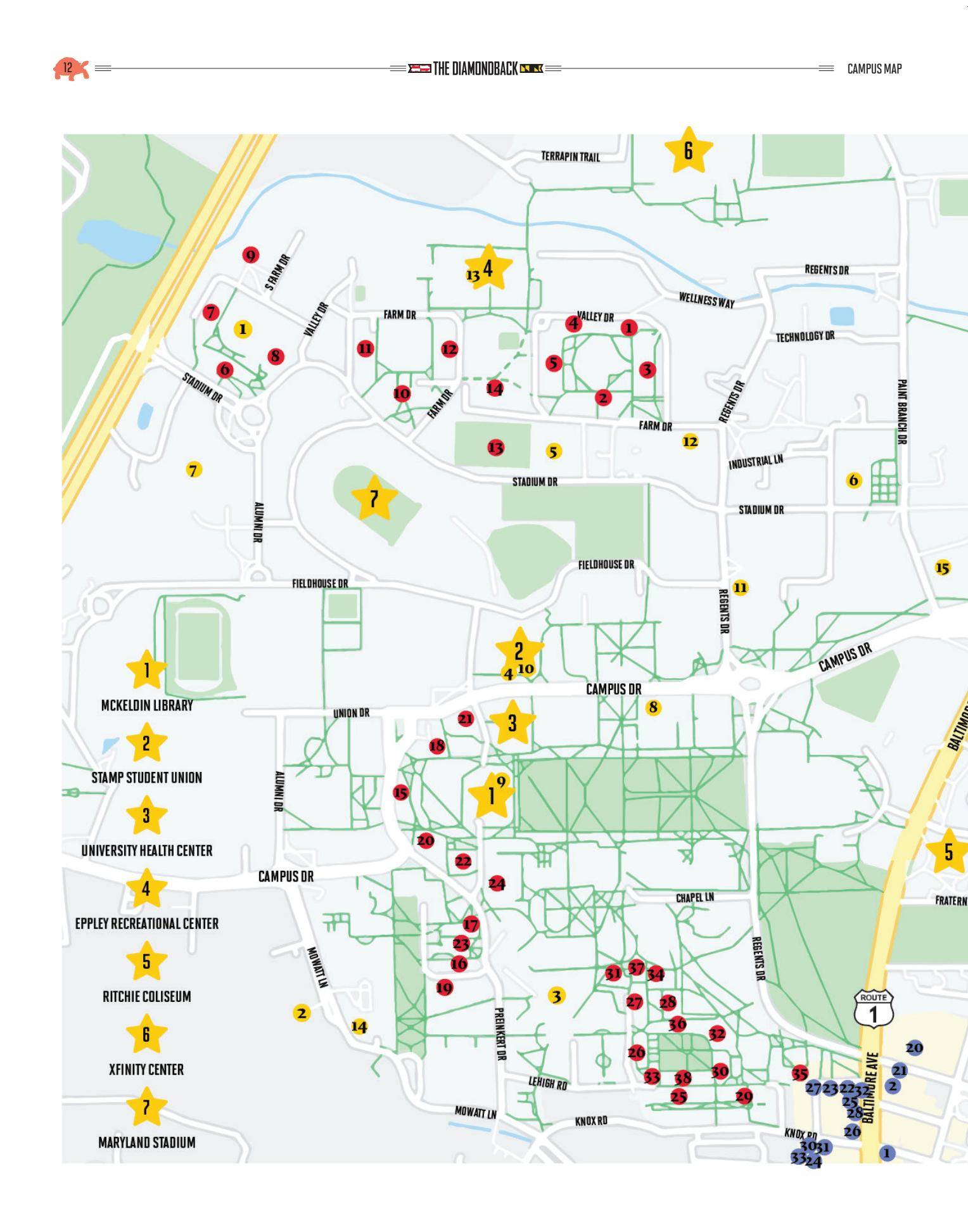

By Irit Skulnik I Sta writer
The University of Maryland RHA passed 26 bills this year, ranging from creating a new mental health committee to advocating for increased sexual health education.
“I’m really proud of the work that we’ve done this year,” Quentin Hoglund, who served as the Residence Hall Association vice president this past academic year, said. “We’re beginning to address a lot of problems that needed to be solved for a long time.” Last year, the RHA passed 13 bills. Michelle Ameyaw, RHA’s recently elected vice president, attributed the increase in bills passed this year to a group of especially passionate senators. Here’s a look at some of the legislation the RHA passed this academic year.
In April, the RHA approved legislation to create a new mental health committee within the organization.
The ad hoc committee was established for the upcoming academic year with a specific focus on mental health, Hoglund said. The RHA will reevaluate its e cacy at the end of next year to decide whether to transition it into a permanent standing committee.
The committee will centralize e orts to create events and educational programs surrounding mental health issues facing students, Hoglund, a senior government and politics major, said.
The RHA passed a bill in October calling for the increased promotion of reproductive and sexual health resources o ered by this university’s health center.
Many students are unaware of the resources available to them, including free STI and HIV testing, free Plan B and birth control consultations, according to Natalie Asbury, the bill’s author.
Since the bill’s passage, Asbury — who is the RHA’s new chief of internal a airs — has been working with the health center and the Department of Resident Life to find ways to better promote these resources and increase sexual health education.
Asbury hopes to implement new promotional materials in collaboration with Resident Life in time for the upcoming fall semester, the sophomore environmental science and policy major said.
Erika Holdren, the RHA’s president over the past academic year, said she thinks this bill will have a significant impact.
“We can take that bill and use it to shape our programming for next year, and it shows that we have a passion for expanding those resources,” Holdren, a junior government and politics major, said.
RHA senators passed a bill in February pushing for the Department of Transportation Services to build more seating and shelters for Shuttle-UM bus stops.
According to the bill, there are a significant number of bus stops at this university that lack seating or shelter.
“It sucks when you go to a bus stop and there’s no benches,” Hoglund said.
The bill’s passage enabled RHA to start collaborating with DOTS to implement the infrastructural changes to “make living and working on campus a lot easier,” Hoglund said.
The RHA also passed a bill supporting this university’s SHIFT project which would streamline the facilities work order system.
4Work — this university’s residential facilities service center — currently manages most of its work order requests on paper and its system is “outdated,” according to Ameyaw, a sophomore biology major.
The SHIFT project would utilize an online system to create a centralized database for all work orders.
The project, set to be implemented this upcoming fall, will benefit both 4Work sta and residents who will be able to e ciently track the status of their requests, Ameyaw explained.
“I know with 4Work, they’ve had some issues with tracking where a certain call may have come from and stu like that, and it was really hard on the workers trying to track all that paperwork,” Ameyaw said. “Because we live in the modern age, that’s not really necessary anymore.”
The organization also passed legislation in January advocating for the creation of a plastic bag recycling program for on-campus residents.
According to the bill, there are no plastic bag drop-o locations on campus. The bill encouraged Resident Life to explore the possibility of putting plastic bag disposal bins in residence halls and the Stamp Student Union food court.
The legislation also proposed various ways to repurpose the plastic bags collected, such as donating them to students with service dogs for waste retrieval or distributing them to students to use with their personal waste bins.
The University of Maryland’s surrounding area is seeing new restaurants and shops open in College Park after a slew of business closures.
New restaurants, such as Dog Haus Biergarten, Iron Rooster and GrillMarx Steakhouse & Raw Bar, have filled oncevacant storefronts in the last year. The College Park Shopping Center will also add a Greene Turtle and Honeypig Korean BBQ.
“We’re smoking hot,” College Park economic development manager Michael Williams said. “Folks want to come to College Park to do business because we have vitality right now.”
The last few months have seen a return of businesses to College Park, which can be attributed to the city’s high foot tra c compared to the rest of the Washington, D.C., area, Williams said.
College Park saw more empty storefronts because of COVID-19 pandemic shutdowns and struggles in the summer, when businesses experience a drought while most students are away from campus, according to District 3 council member Stuart Adams.
Now, the new City Hall building’s restaurant storefront is almost filled with places such as Dog Haus Biergarten, Smoothie King and Shop Made in Maryland after two years of multiple vacancies.
Some College Park apartments are following a major development trend by placing retail on the first floor. Union on Knox, an apartment complex set to open in fall 2024, will include Chopt Creative Salad Company and Shake Shack among its retail selection.
Project Turtle — an apartment complex in its design phase that will replace the Campus Village Shoppes — will bring back some old businesses on its first floor, including Taqueria Habanero, Hanami Japanese Restaurant, Mr. Fries Man and the UPS Store, according to a news release from LV Collective, the complex’s developer.
The Hotel at the University of Maryland also emulates this type of development and has recently filled its retail openings with the addition of Iron Rooster.
The College Park business scene has also seen some closures this year.
The city is slowly becoming a “dry” area with the closure of two major liquor stores — Town Hall and College Park Liquors — in the Campus Village Shoppes shutdown. Williams said he is working to attract one of the old liquor stores back to the area.
By Katharine Wilson I Sta writer
Some other businesses have closed in about the last year, including Taim Mediterranean Kitchen, BookHolders and all businesses at Campus Village Shoppes.
The majority of storefronts around this university are owned by national and regional firms, which results in high rent for retail spaces across the city, according to Adams. A key to keeping small businesses open is attracting foot tra c during the summer with city gatherings, sports leagues and events at this university, he added.
With more chain restaurants coming to the city, Williams said he would like to attract more small businesses and local chains to the area but high rent pushes these businesses away.
In the city’s 2024 budget, $75,000 was set aside for retaining businesses, according to College Park Mayor Fazlul Kabir’s website. Individual businesses in the city will also receive $15,000 to a possible $200,000 in additional funding to attract, aid and resettle businesses, The Diamondback reported in October.
“It may appear that we’re going national all over the place, but not really,” Williams said. “We really are making the e ort with the business retention fund to help the locals stay.”
City demographic data also show students are staying in College Park after graduation, Williams said. This could mean employers will start to move to the city and make it the next tech hub, he added.
The new FBI headquarters planned near the Greenbelt Metro Station will also likely encourage more tech companies to
move to the city and the Discovery District, according to Adams. The thousands of FBI employees in the immediate College Park area will help the economy year round, Adams said.
“The future of College Park in terms of business opportunity is excellent,” Adams said. “It’s going to be even greater once the FBI gets here.”
A diverse range of housing at di erent price points, District 3 council member John Rigg said, would also help College Park support a year-round workforce and customer base for businesses. He cited Aster and Atworth, a new apartment building next to the College Park Metro station, as two examples of workforce housing opening in the city.
People and businesses are attempting to stay in College Park, and the city is hoping to grasp onto this momentum.
“There’s a lot of opportunity and it’s just a matter of continuing to build the yearround population,” Rigg said.

Save the research for studying, and join our 2024 waitlist today.
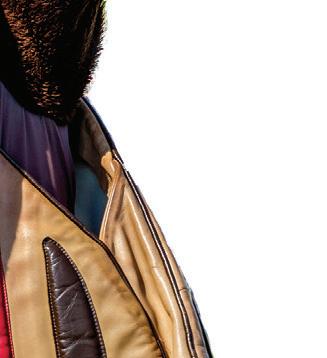
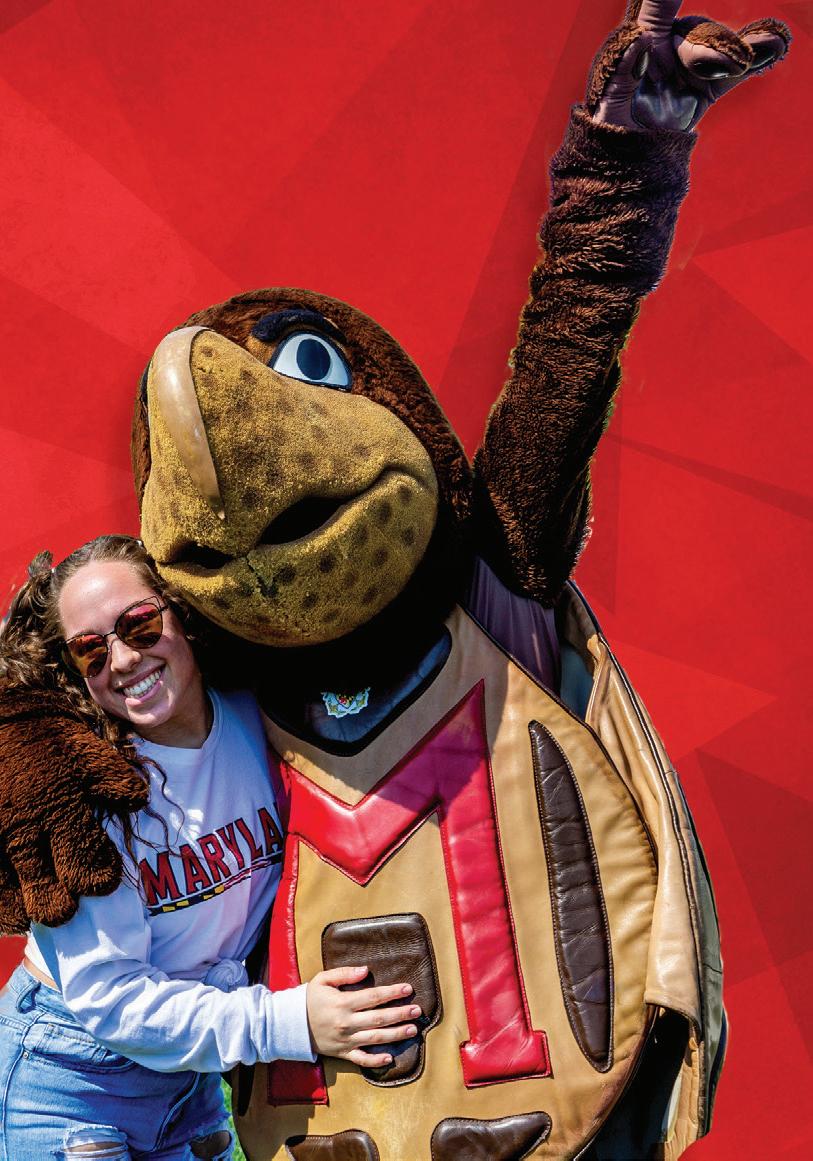


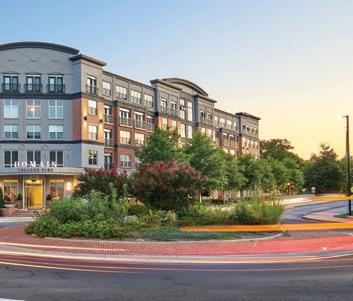



University of Maryland students and faculty expressed mixed reactions to the university’s new transfer requirements for the computer science major, which will significantly decrease the number of transfers into the fast-growing major.
The new computer science transfer requirements, announced this fall, will increase the number of freshmen admitted directly to the major from 450 to 600 students. It will also decrease the number of transfers into the major by 90 percent, from 1,000 to 100 students. The requirements will apply to students entering the university beginning in fall 2024 and will not a ect students currently attending the university.
The requirements include more stringent academic thresholds for students to transfer into the computer science major.
The university raised the prerequisite GPA to enter the major from 2.7 to 3.0. Students must also attain a minimum grade of B- in some introductory computer science courses. In previous years, students had to achieve a minimum grade of C- in these courses.
The changes will apply to external transfers — students transferring from di erent universities — and internal transfers, which are students changing majors at this university.
Transfer is also no longer guaranteed into the major, even if the requirements are met.
According to the computer science department’s website, students who are admitted to the university but not to the computer science major
“must be prepared to select an alternate major.”
In a statement to The Diamondback, the computer, mathematical and natural sciences college, which hosts the computer science major, said computer science is the most popular major on campus and a significant factor in designing the new requirements. The statement also cited the major’s designation as a limited enrollment program in 2018.
“The LEP has increased selectivity and improved student success, but it has not resulted in lower enrollment,” the statement read. “Lower enrollment is necessary to better match our faculty, teaching assistant, academic advisor and instructional resources.”
Since the major’s designation as a limited enrollment program in 2018, the number of undergraduate computer science majors has increased by more than nine percent to 3,725 students in fall 2023.
Larry Herman, a computer science lecturer who teaches some introductory computer science courses, said the new policy will reduce overcrowding in classrooms and help increase learning quality.
“I do think that it’s going to help our program to have class size a little smaller,” Herman said. Herman, who has been teaching at this university since 1995, added he is currently teaching 600 students in a course.
61 percent of classes in the computer science department have a class enrollment of 50 or more
By Lillian Glaros I Sta writer
students in fall 2023. The average course size has also increased by more than 20 percent since fall 2018.
Large class sizes mean that instructors do not have as much time for individual students and some students feel discouraged from asking questions, Herman noted.
But some of this university’s current and prospective students said the new transfer requirements are an additional stress in the application process.
Leo Nguyen, a senior at Eleanor Roosevelt High School in Greenbelt, applied to this university for computer science in this year’s application cycle. He highlighted that if he was not directly admitted into computer science, he would need to invest more time in his studies.
“I will most likely have to invest more time to make sure that my GPA is up to par,” Nguyen said. “It will probably be more stressful.”
Nguyen added that he is unsure whether he would choose to attend this university if he was not directly admitted to the major.
Shivank Bhimavarapu, a freshman enrolled in letters and sciences who is hoping to major in computer science, sympathized with prospective students who will be a ected by the new transfer requirements.
“I just feel bad that the requirements are so much more heightened … especially because college applications are also getting a lot more competitive,” Bhimavarapu said.

Sports can be one of the most exciting aspects of college, and at Maryland you’ll get a game day experience that’s hard to beat. Here’s how to get the most out of your trip to the stadium.
For every home football game, the campus is crowded with fans of all ages. You’ll want to take part in the revelry at a tailgate, and there are plenty of options to choose from:
The IFC tailgate: The Interfraternity Council tailgate has been held previously near Lot 1, and it’s could require wristbands to enter. If you’re able to get your wrists on one, there’s tons of food, drinks and games in store.
Terp Up for Game Day: Two hours before every home game, La Plata Beach turns into a huge tailgate zone with games and giveaways. Host your own: Parking on campus isn’t cheap (see page 16 & 17 for more on that), but if you’re able to swing a spot on Saturday, you might as well bring a grill and some burgers. Check out the tailgate rules so you don’t get in trouble — you won’t be able to watch the game if you’re booted from the campus.
Also, make sure to BYOF (Bring your own food), as no tailgate is complete without a few snacks. Concessions are sold within the stadium, but when you’re preparing for a multi-hour game, it’s always smart to have a bite to eat before you head in. It might even save you a few bucks!

For sports such as football and men’s basketball, student tickets can disappear quickly, so you’ll want to be ready to claim them. To set up your account for student tickets, go to umterps.com/student.
Pay attention to your email. You’ll get a message for the start of each request period — which is the time you can request a ticket for a given game. When putting in your order for a ticket, make sure to select “Mobile PDF Delivery.” That way, you can have it stored on your phone instead of printing it out. And this should go without saying, but if you get a ticket, use it! It’ll help you build up loyalty points, giving you a better shot of getting more in-demand tickets in the future.
The crowd: At any Maryland sports game, whether it’s against a hated Big Ten rival or an uninspiring mid-major foe, you’ll be among a boisterous crowd that isn’t afraid to get in on the action. From chants and songs to creative signs and coordinated antics, everything goes when the Terps are playing. It’s deafening, it’s vulgar and it’s among the best things you’ll experience here.
The flash mobs : Since 2011, one Maryland men’s basketball game a year has featured a flash mob. You’ve probably seen the videos before: The entire arena is in sync, wearing the same thing and moving the same way as the music pounds. Get to the game a couple hours beforehand to learn the choreography and you can take part in this experience.
The Maryland flag: If you start to hear the theme from 2001: A Space Odyssey, you’re about to take part in maybe the best tradition Maryland has to o er. During home games for football and men’s basketball, a massive Maryland flag is unfurled across the student section. When it comes to you, do your part for Maryland pride - hold it up and pass it along. (And don’t worry — it won’t be there too long.)
If you go to enough sporting events at Maryland, you’re going to get a lot of free stu . T-shirts are the most common giveaway, and for every straight forward design, there’s a wacky outside-the-box one,like the football T-shirts featuring Testudo memes. There’s plenty of other stu too, such as bobbleheads, beanies, scarves and even capes. Be on the lookout for emails promoting a giveaway and get to the stadium on time. The freebies won’t be around forever.
This article is part of The Diamondback’s 2023 Orientation Guide. Some information and resources have been updated to reflect current dates and events.

4141 Guilford Drive College Park, MD 20740 (301) 864-6223 www.catholicterps.org CATHOLIC STUDENT CENTER
Welcome!
The Catholic Student Center is open for Mass, Confession, prayer, studying & hanging out.
Join us weekly each semester for Wednesday Night Mass and dinner 5:30 pm
Now that you’ve been accepted into the University of Maryland, you may be navigating the financial aid process or wondering what you could have done di erently. The financial aid process can be daunting, but this explainer should help demystify the process.
College comes with a big price tag.
Over the past three decades, college tuition costs have skyrocketed. At four-year public schools, in-state tuition has jumped from about $4,000 annually to almost $11,000, according to 2022 data from the College Board.
But don’t fret — here’s a breakdown of di erent types of financial aid and some tips to help you along the way from a seasoned scholarship applicant.
By now, you might already know what FAFSA is and why it’s important. But as a refresher, FAFSA, otherwise known as the Free Application for Federal Student Aid, allows students pursuing undergraduate or graduate degrees to apply for federal financial aid. This can be applied toward tuition, fees, room and board, textbooks and other school-related expenses.
Some states also have financial aid programs for state residents who attend college in the state and outside of it, as well as out-of-state students. In Maryland, there’s MDCAPS, which processes applications for state-sponsored scholarships. Programs like this usually use the information entered in your FAFSA application to determine what kind of state-based aid you would be eligible for.
Regardless of how you or others may perceive your financial situation, it’s still important to apply for both federal and state-based aid because you may still be o ered federal aid or your application can be used for state awards.
By Amanda Hernández | Updated by Monica Godnick
Now, you’re probably curious about what types of aid exist and how they work. Below, you’ll find a breakdown of each one.
Scholarships come in all forms, shapes and sizes. You also don’t have to repay the amount back. Scholarships can be either merit-based or based on a student’s financial need. You can find thousands of scholarships to apply to online, but don’t forget to also apply to smaller, local ones in your area. If you already know what you’re majoring in, I highly recommend searching for professional groups related to your major that fund scholarships. If you live in Maryland, you can also apply for delegate and senatorial scholarships.
Grants are another great way to fund your education. You don’t need to worry about paying these back either. Most grants are given to students based on financial need, but that shouldn’t stop you from applying if you can. The federal government o ers several grants through FAFSA, such as the Federal Pell Grant. Universities also sometimes o er grants. Direct unsubsidized loans, though, are not based on financial need and students are responsible for paying the interest.
Loans are where it gets really tricky in the world of financial aid. A loan is money you borrow from the government, bank, financial institution or other organization, which you must pay back with interest. Private loans can be more di cult to navigate, but federal student loans usually have more benefits, according to the U.S. Department of Education. The two most common types of federal student loans are direct subsidized or direct unsubsidized. Direct subsidized loans
are based on financial need and do not need to be paid until you graduate. Direct unsubsidized loans, though, are not based on financial need and students are responsible for paying the interest.
Last, but certainly not least, federal work-study provides students who show financial need with part-time jobs. The work-study program is available to both full-time and part-time students. The money earned is meant to help students cover education-related expenses.
If you’re a transfer student, you might be wondering what kind of aid you’re eligible for. You should still apply for FAFSA and any state-based aid you qualify for, but as a transfer student, you also have access to additional scholarships or financial aid programs specifically for transfer students. At this university, transfer students are automatically reviewed for some merit scholarships, while other scholarships require an application.
Navigating the financial aid process is hard enough as it is, but as an undocumented student, it can be even more daunting. While some financial aid programs require students to be U.S. citizens, you can also find scholarships or other programs that o er financial assistance to undocumented students.
The Immigrant and Undocumented Student Life Program at this university also o ers an extensive online list of scholarships and other financial resources available to undocumented students. In the case of private scholarships, nonprofits like TheDream.US or Golden Door Scholars have opportunities that are specifically meant to help undocumented students.
Ahora que usted ha sido aceptado en la Universidad de Maryland, puede ser que esté navegando por el proceso de ayuda financiera, o preguntándose qué podría haber hecho de manera diferente. Lo que sí se sabe con seguridad es: El proceso de ayuda financiera es abrumador y desalentador. La universidad trae consigo un costo muy alto.
Durante las últimas tres décadas, los costes de la matrícula universitaria se dispararon. En las escuelas públicas de cuatro años la matrícula ha aumentado de unos $4.000 anualmente a casi $11.000, según los datos del College Board de 2022. Pero no se preocupe — aquí hay un desglose de diferentes tipos de ayuda financiera y algunos consejos para ayudarle con el proceso.
Ayuda federal y estatal
Es posible que ya sepa qué es FAFSA y por qué es importante. Pero como recordatorio, FAFSA, también conocida como la Solicitud Gratuita de Ayuda Federal para Estudiantes, permite que los estudiantes que buscan títulos universitarios o de graduados soliciten ayuda financiera federal. Esto puede aplicarse a la matrícula, tarifas, pensión completa, libros de clase y otros gastos relacionados con la educación.
Algunos estados también tienen programas de ayuda financiera para residentes del estado que asisten a la universidad en su estado y fuera de él, así como para estudiantes fuera del estado. En Maryland, existe el MDCAPS, que procesa las solicitudes de becas patrocinadas por el estado. Programas como este generalmente utilizan la información ingresada en su solicitud de FAFSA para determinar para qué tipo de ayuda estatal usted sería apto.
Independientemente de cómo usted u otros perciban su situación financiera, es importante solicitar ayuda tanto federal como estatal, ya que aún le pueden ofrecer ayuda federal o su solicitud puede ser apta también para premios estatales.
Ahora bien, es probable que tenga curiosidad sobre los tipos de ayuda que existen y cómo funcionan. A continuación, encontrará un desglose de cada uno de ellos.
Desglosando los diferentes tipos de ayuda.
Las becas se presentan en todas las formas y tamaños. Además, no es necesario devolver la cantidad de dinero otorgada. Las becas pueden ser basadas en méritos o basadas en la necesidad financiera del estudiante. Puede encontrar miles de becas para solicitar en línea, pero no se olvide de postular también para las más pequeñas y locales en su área. Si usted ya sabe en la carrera que se va a especializar, le recomiendo que busque grupos profesionales relacionados con su especialización que financien becas. Si vive en Maryland, también puede postular para las becas de delegados y las senatoriales.
Las subvenciones también son otra manera excelente de financiar su educación. Tampoco es necesario preocuparse por pagar estos gastos. La mayoría de las subvenciones se concede a los estudiantes en función a las necesidades financieras, pero eso no debería disuadir a uno de completar una solicitud. El gobierno federal ofrece varias subvenciones a través de FAFSA, como la Federal Pell Grant. Las universidades también ofrecen subvenciones a veces.
En el mundo de la ayuda financiera, el tema es más complicado cuando se trata del proceso de los préstamos. Un préstamo es dinero que usted pide prestado al gobierno, un banco, una institución financiera u otra organización, que se debe pagar después con intereses. Los préstamos privados pueden ser más difíciles para navegar, pero los préstamos federales para estudiantes suelen tener más beneficios, según el Departamento de Educación de los Estados Unidos. Los dos tipos de préstamos federales más comunes para estudiantes son préstamos subsidiados o préstamos directos no subsidiados. Los préstamos directos subsidiados se basan en la necesidad financiera y no se necesitan pagar hasta después de haberse graduado. Los préstamos directos no subvencionados, sin embargo, no se basan en la necesidad financiera y los estudiantes son responsables de pagar los intereses del préstamo.
Programas de trabajo y estudio Por último, pero no por ello menos importante, el programa de trabajo y estudio federal proporciona empleos de tiempo parcial a los estudiantes que demuestren necesidades financieras. El programa de estudio de trabajo está disponible tanto para estudiantes de tiempo completo como de tiempo parcial. El dinero ganado está destinado a ayudar a los estudiantes para cubrir los gastos relacionados con su educación.
Si es un alumno que se ha transferido de otra universidad, puede que se esté preguntando para qué tipo de ayuda es apto. Aún debería postular para la FAFSA y cualquier ayuda estatal a la que usted califique, pero como estudiante transferido, también tiene acceso a becas adicionales o programas de ayuda financiera específicamente para estudiantes que se transfieren de otras universidades. En esta universidad, los estudiantes que se transfieren son automáticamente considerados para algunas becas de mérito, mientras que otras becas requieren una postulación.
Recursos para estudiantes indocumentados
Ya es bastante difícil navegar el proceso de ayuda financiera, pero como estudiante indocumentado, puede ser aún más desalentador. Mientras que algunos programas de ayuda financiera requieren que los estudiantes sean ciudadanos estadounidenses, también puede encontrar becas u otros programas que ofrecen asistencia financiera a estudiantes indocumentados.
El Programa de Vida Estudiantil para Inmigrantes e Indocumentados en esta universidad también ofrece una lista amplia en línea de becas y otros recursos financieros disponibles para estudiantes indocumentados. En el caso de becas privadas, organizaciones sin fines de lucro como TheDream.US o Golden Door Scholars específicamente ofrecen oportunidades para ayudar a los estudiantes indocumentados.
Stamp Student Union has several fast food restaurants. Some highlights include Chick-fil-A, Panera Bread, Panda Express and Qdoba, which are all located in the main eatery. There’s also a Subway in TerpZone, a co ee shop near the main entrance that serves Starbucks and a Panera Bread on Stamp’s first floor.
If you’re in a rush, head to Stamp’s convenience shop to assemble your own meal. You can grab a quick packaged and
Chick-fil-A
Hibachi San MD Dairy
Moby Freestyle
Panda Express
Panera Bread
Qdoba Saladworks
Subway
The Co ee Bar
Union Pizza
prepared sandwich and add on fruit, yogurt or a bag of chips.
Stamp is also home to the Dairy, an ice cream shop that serves a wide variety of university-crafted flavors, such as Fear the Turtle.
There’s also a lot of food outside of STAMP. Cafes with standard convenience store fare are scattered across campus in academic buildings such as Applause at The Clarice Smith Performing Arts Center or
Applause
The Clarice Smith Performing Arts Center
Breakpoint
The Iribe Center Food for Thought
The Edward St. John Learning and Teaching Center
Footnotes
McKeldin Library
Quantum in the Physical Sciences Complex. Every Wednesday from April through mid-November, the Farmers Market sets up camp at Tawes Plaza Garden for a couple hours, o ering produce, eggs and pastries, as well as some specialty products such as jewelry and beeswax products. Everything sold here is grown or produced by the vendor selling it.
IDEA Central
IDEA Factory
Quantum
The Physical Sciences Complex
Rudy’s
Van Munching Hall
Sneaker’s
Eppley Recreation Center
E+M Cafe
Kirwan Food Court
*This article is part of The Diamondback’s 2022 Orientation Guide. Some information and resources have been updated to reflect current dates and events.

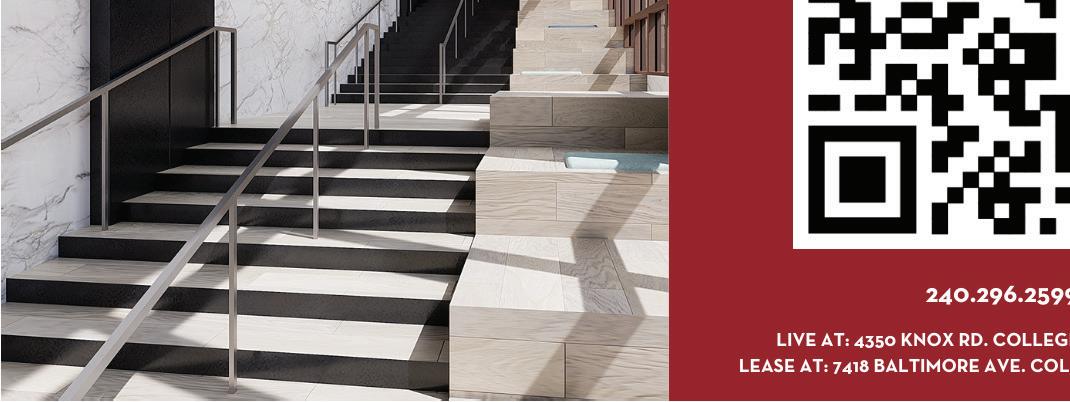
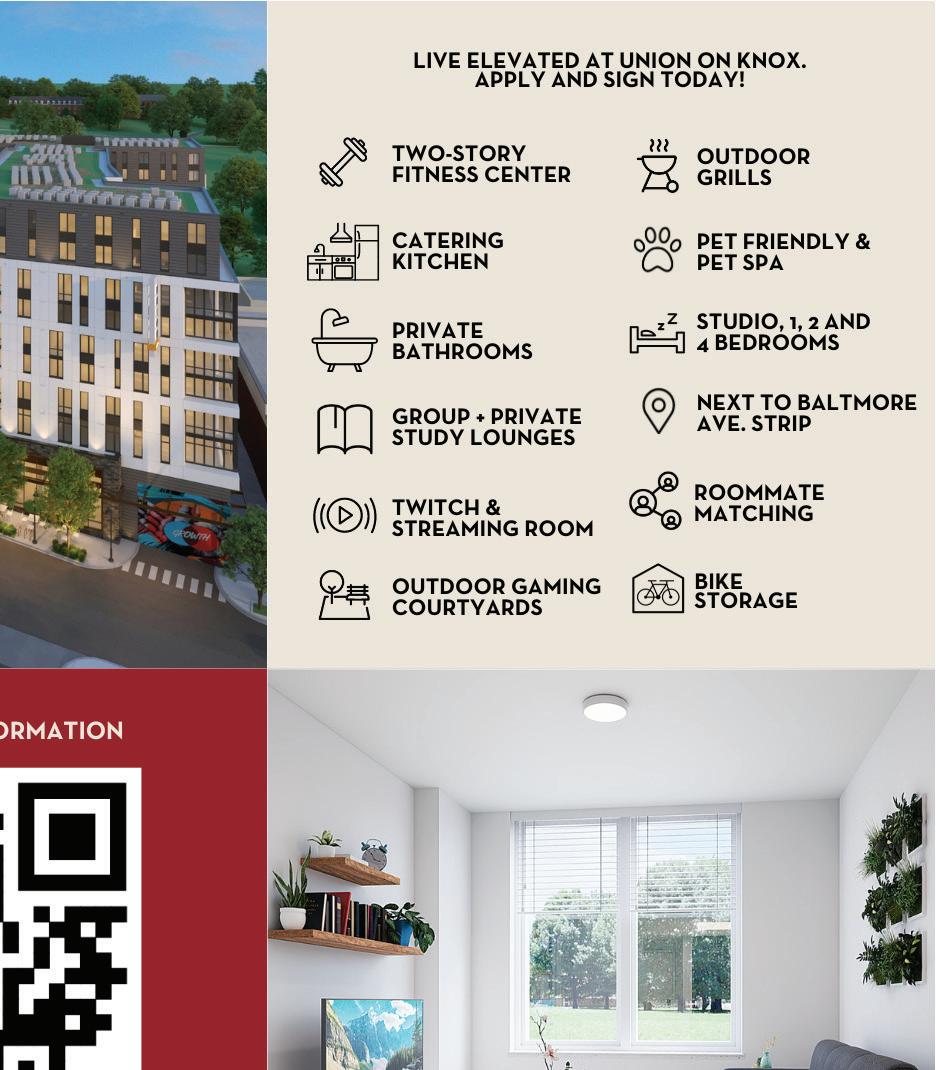


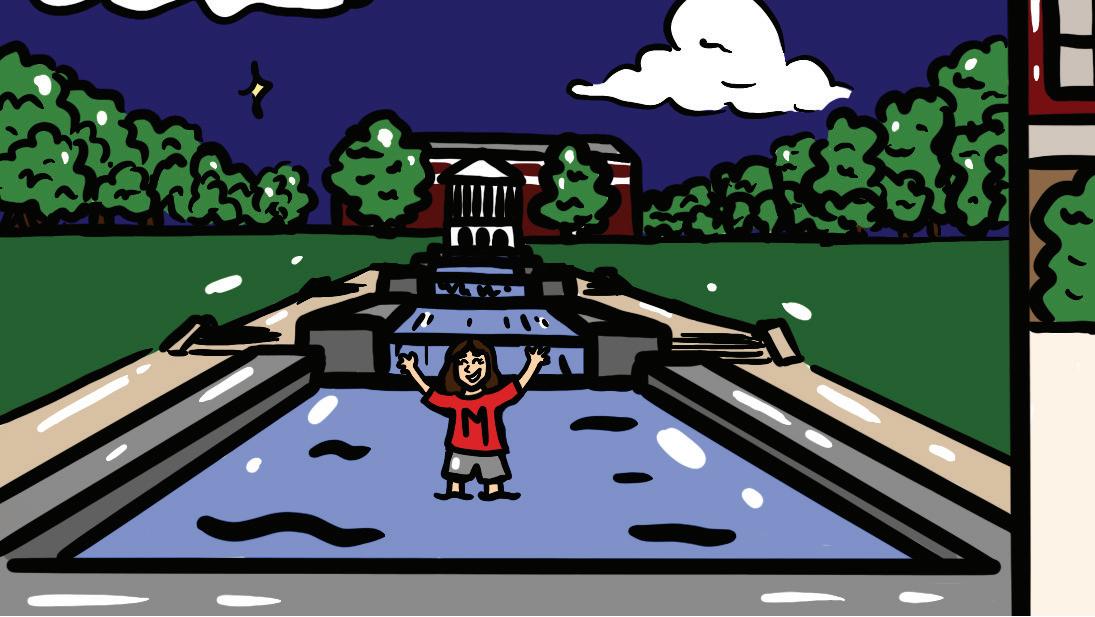



Beneath the fluorescent lights of an after-hours Tawes Hall classroom, a group of University of Maryland students — their leader with a tiki torch in hand — enter for Survivor Maryland’s tribal council.
Though the students smile and joke with each other, the weight of their decision looms. The team, referred to as a tribe, must eliminate one friend, ally and teammate from the game. These recognizable tribal councils are only a small fraction of the massive production that is Survivor Maryland.
“There are three factions to Survivor Maryland. Its crew, players and [executive board]. Players are the centerpiece of our club,” said junior English major and the 80-person organization’s co-president Madeline Arcaro.
Students who sign up to play complete random and occasionally demanding challenges, such as holding onto the poles at Xfinity Center for as long as possible or wrestling each other to bring a tire to their side of a field.
Players also perform tasks throughout campus in “taskmasters” — such as sending emails asking for the best date spots in College Park — to push each other out of their comfort zones.
By So a Appolonio I Diversions editor
and develops the season. Members such as sophomore journalism major and head of twists Jack Wynn keep the challenges exciting.
Wynn, a self-proclaimed Survivor fan, develops the unexpected portion of the game including hidden advantages, immunity idols and possible shocking alliances. He came in sixth place as a player last season.
Wynn said that while the game can be misconstrued as a social experiment, playing successfully depends more on the relationships players make.
With challenges that reach nearly 15 hours,
information science major said. “All the people that you play with really become such a tight knit family.”
As a player, Oumarou enjoyed completing and watching the taskmasters, reminiscing on challenges like sledding down Stamp Hill with an egg in one’s mouth — or dancing in a conga line with 10 strangers.
Although the game presents itself as a fun weekly activity and social club, people grow into wanting to prove themselves as competitors, Oumarou said.
“The club just consumes everyone who gets into it. It’s why everyone from our season keeps coming back just to watch the new people have their experience or to be in an exec position.” Oumarou said.

it’s di cult to not grow close with other players.
The film crew records each council, challenge, 45-minute confessional session and interaction between the players during the season, equipping at least three cameras at all times.
Every conversation each person has in the game is recorded, Arcaro said.
By the end of one season, the crew amasses thousands of hours of footage. Despite the club’s 22–season run, only seasons two through seven are uploaded to its YouTube channel.
“All the footage goes to the host and the hosts edit their own seasons,” Arcaro said. “Editing it takes years and years. The season that’s currently airing [on YouTube] was filmed all the way back in 2017.”
The executive board manages recruitment
In a season 20 challenge, players held onto the McKeldin sundial for as long as possible. This activity lasted 14 hours and 56 minutes, breaking the record for the longest challenge in college Survivor’s history, Arcaro said.
Despite the demanding schedule, with executive board members sometimes working 40 hours a week, past competitors such as Wynn and Arcaro return to help edit, recruit or plan the next seasons.
Community recruitment head Malik Oumarou placed second during his season, and said he enjoyed how the game compelled him to try new activities.
“[It’s] a weird way to put myself out there, out of my comfort zone with a bunch of people I would never interact with naturally,” the junior
In the three years since last season aired on YouTube, Arcaro said Survivor Maryland has slowly regained its presence on campus through noticeable tasks and challenges, but the organization also prides itself on fostering a sense of community — one that extends beyond this university.
This university’s Survivor is the first edition of any college Survivor. In its footsteps came other survivor clubs who reached out to Survivor Maryland for advice on starting their chapters.
The colleges have built an extensive network of alumni and current players from schools including Northeastern University, University of Connecticut and University of Michigan.
Arcaro said she’s proud of the community Survivor Maryland has built, and for fulfilling her own mission to diversify the club further as one of the few women to host.
“The fact that I feel like I’ve made a lot of changes in the two years that I’ve been here, I’ve been really, really proud of,” Arcaro said. “I’m excited to see just the way that continues to grow even after I graduate.”
As the 2023-24 sports seasons began winding down, it looked like the Terps would have one of their more underwhelming years in recent memory — then came Maryland men’s lacrosse to the rescue.



The seventh-seeded Terps lost four of their last seven games entering the NCAA tournament, but an improbable run to the national championship, where they fell to Notre Dame and finished as runner-ups, ended the year on a high note for Maryland’s sports.







By Eli Cohen I Sportseditor

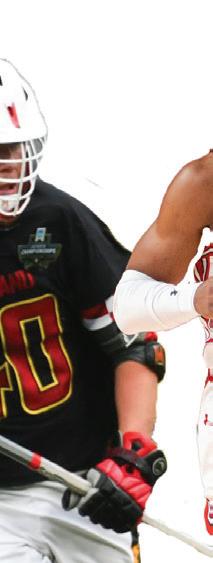





The Terps saw other deep runs from their field hockey and women’s lacrosse teams, a pair of national powerhouses that both reached the NCAA quarterfinals. But such feats have become the norm, and if anything, the teams slightly underperformed given their pedigree.



of that this

The eight-time NCAA champion field hockey team reached consecutive Final Fours beforfalling a round short year, while the 15-time champion women’s lacrosse team reached 11 straight semifinals before missing three of the past four.
Maryland football won its third straight bowl game, defeating Auburn, 31-13, in the Music City Bowl, to reach eight wins for the second straight season.
It was an up-and-down year for the Terps — who won their first five games before dropping their next four — but they ended it on a high note. Now, they’ll have to find a way to carry on the success without quarterback Taulia Tagovailoa.
Although coach Mike Locksley’s team didn’t take a leap in Tagovailoa’s final year, it at least maintained the success from previous years. Maryland’s men’s and women’s basketball teams can’t say the same.
Maryland’s men’s basketball team finished with a losing record for just the second time in the last 30 years. The Terps reached the second round of the NCAA tournament in their first year under Kevin Willard, but stumbled in his second season at the helm. Maryland women’s basketball reached March Madness but ended its season in the first round after advancing in the last 11 tournaments.
Pictured Above:
Men’s lacrosse: Colin Burlace (Jordan Budney/The Diamondback)
Men’s Basketball: Jahmir Young (rohan pandit / the Diamondback)
Women’s Basketball: Shyanne Sellers (rohan pandit / the Diamondback)
Football: Ruben Hyppolite II (Eric Robinson / the Diamondback)
Women’s Lacrosse: Chrissy Thomas (Eric Robinson/ the Diamondback)
Field Hockey: Brooke DeBerdine (Cam Andrews/ the Diamondback)
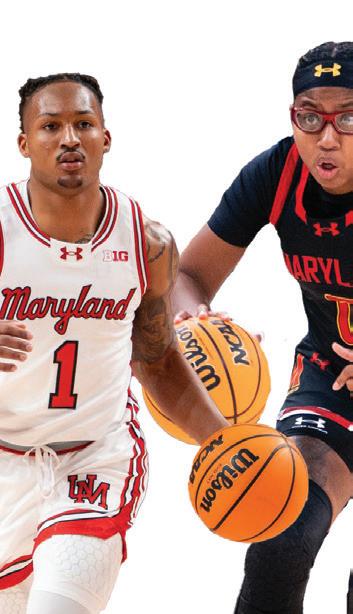
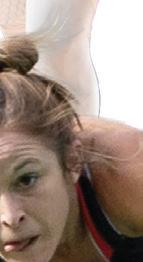


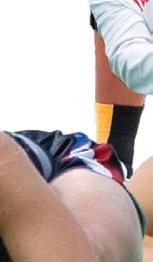













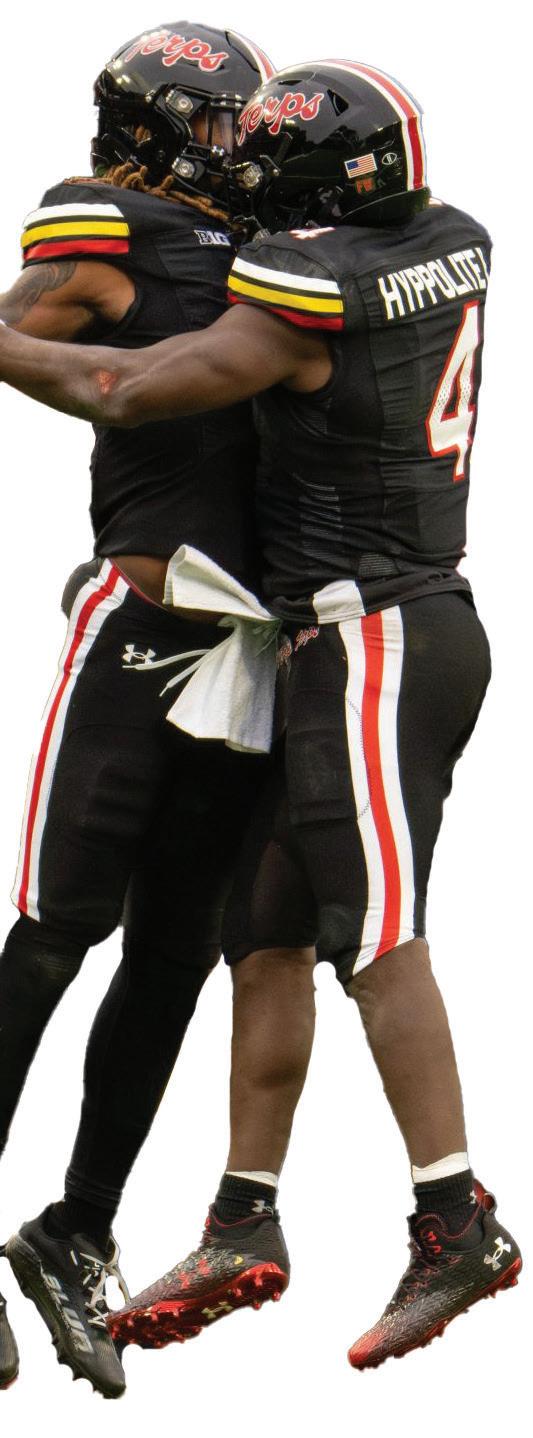




The College Park City Council approved an amended needs-based student housing rental subsidy pilot program on Tuesday after months of contentious debate.
The amended pilot program will grant 60 subsidies of $1,250 to full-time undergraduate students who qualify for a Federal Pell Grant and have a rental lease in a College Park apartment or house. Another 60 subsidies of $1,250 will be given to full-time graduate students with a lease in College Park earning 60 percent or less of the area median income.
Council members voted 5-3 to move forward on the program with amendments from District 2 council member Susan Whitney. The council also voted 8-0 to create a task force to further explore how the city can help residents with rising housing costs.
Whitney acknowledged the pilot program will only provide a small amount of financial assistance to College Park renters, but sees it as a starting point.
“We’re trying to provide relief,” Whitney said. “I hope it’s a bridge to get to a better, more sustainable program.”
The original version of the pilot program
By Eden Binder I Sta writer
would have given 75 subsidies of $1,500 to fulltime undergraduate students who qualify for a Federal Pell Grant and have a lease in a city apartment and 75 subsidies of $1,500 to income-eligible and full-time graduate students with a College Park apartment lease.
Whitney’s amendment lowers the program’s impact on the city budget by $75,000. Expanding the program beyond rental apartments to include all rental properties within College Park will also include students who live in single-family homes, Whitney said.
Abel Amene, a senior economics and physics major at the University of Maryland and an o -campus outlying representative for this university’s Student Government Association, testified about the pilot program on Tuesday and discussed previously experiencing homelessness. He said the pilot program has the potential to help him and other students.
Albus Du, a freshman government and politics and neuroscience major at this university, told the council he is secure in his housing, but still notices housing una ordability throughout College Park. The pilot program will help address students’ housing insecurity, he said.
“We spend boatloads of money every year in the city,” Du said. “By supporting the student body, you are supporting College Park.”
Some locals, such as College Park resident Beth McAllister, told the council that residents should not be responsible for
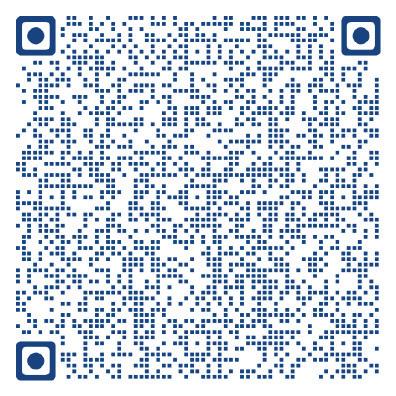
funding the pilot program.
“I have already paid for my four kids,” McAllister, who is also The Clarice Smith Performing Arts Center’s financial coordinator, said. “I don’t think that I should have to pay for everybody else’s kids.”
Pilot program applicants will be selected by a lottery process and awarded with the grant once they verify their eligibility. The program will be funded by the three-cent tax increase on apartment, commercial and industrial properties in the fiscal year 2024 budget.
District 1 council member Alan Hew voted in favor of the pilot program based on his own struggles paying for college.
“I paid on my own, took out student loans and I know what it is to struggle, sometimes working two jobs,” Hew said.
Hew hopes that the council follows up on and studies the pilot program in the future.
The city will also collect and share data to understand housing needs in the new task force.
Deputy student liaison Gannon Sprinkle believes Tuesday’s decision to approve the pilot program was a victory and is thankful for the students who expressed their support.
“We could have not done it without [the students],” Sprinkle, who was a non-voting member of the subcommittee that discussed the pilot program, said. “We have tried our entire year to get College Park students engaged in the policymaking process and this was the culmination of our e orts.”
The subcommittee presented its final report to the council last week and disbanded after.
City sta will now work with the council to release applications for the program in the coming weeks.

You must not keep your hands in your pockets. You must fold your arms during dining hall announcements. You must tip your cap when you speak to upperclassmen and always address them with a “sir” and “pardon.”
These are not the rules of an elite military boarding school, nor the laws from some dystopian, authoritarian academy. These are the freshman rules from the Handbook of the University of Maryland — published in 1924.
This university’s College Park and Baltimore campuses’ Young Men’s Christian Associations jointly published this student handbook, an ancestor of the more famous M Book. Within its yellowed pages lies a capsule of this university’s past, a history forgotten in the century since then.
Preceding with a message from then-university president, Albert F. Woods, and a handful of directory notes, the handbook, which can be
By Adam Hudacek I Tabloid editor
read in full in the university library’s archival collection, provides a picture of this university’s 1920s structure. The time-worn and occasionally blotched pages contain songs, rules and advertisements.
The handbook lists seven sports — football, baseball, basketball, lacrosse, track, tennis and cross country — along with a variety of student clubs and organizations, including the girls’ rifle team, an exclusively women’s sport with no men’s team listed, and our very own The Diamondback, led by future NBC Radio star John White.
Beyond limited extracurricular opportunities — compared to the more than 650 student organizations available today — students at this university, especially freshmen, were subject to a strict list of rules, guidelines and regulations. Freshmen were forbidden from displaying insignias on their clothes unless explicitly earned
at this university. They were required to wear a rat cap, an early style of baseball cap, at all times. All freshmen were barred from crossing across campus, and were to limit themselves to cinder and cement walkways.
Dining halls saw similar restrictions, with freshmen disallowed from sitting at the heads of tables unless given express permission by an upperclassman. Before taking their seats, all freshmen were instructed to form lines of two and always “ask for and pass things cheerfully.”
Not all policies were aimed squarely at the university’s youngest students. Skipping class near a break in 1924 would result in more than your TA’s disapproval — it came with a $3 fine charged for each course missed.
Article continued at the bottom of Page 30.
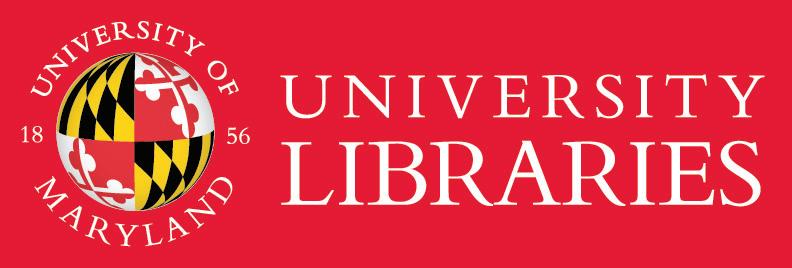
By Irit Skulnik I Sta writer
Samantha Briggs will serve as the next University of Maryland RHA president after being elected earlier this month, according to the organization’s current leadership.
Briggs currently serves as the chief of internal a airs for the organization. She ran unopposed in the presidential race and was elected on April 9 alongside the incoming vice president Michelle Ameyaw. They will o cially start in their positions May 8, Briggs said.
The junior government and politics major said she decided to run for president because she’s passionate about supporting students and improving their college experience.
“I enjoy advocating for student voices and helping them to be heard and then addressing key issues that impact students on our campus,” Briggs said.
The president’s responsibilities include overseeing the executive team, coordinating with council presidents, serving on various committees and acting as an advocate for students who live on campus, outgoing Residence Hall Association president Erika Holdren said.
Briggs joined RHA in her freshman year, starting as the vice president of sustainability for Hagerstown Hall. She has also served as the chair of the sustainability committee and the sustainability coordinator before her current
position, Briggs said.
Holdren, a junior government and politics major, said Briggs’ time as chief of internal affairs gave her management skills that will help her as president.
“She learned how to help manage the team and be concise in meetings and make sure that everyone is being heard,” Holdren said. “That’s definitely transferable to a larger scale.”
In her freshman year, Briggs started the adopt a garden initiative in which the sustainability committee worked with this university’s arboretum to help them clean up and mulch the trees on McKeldin Mall.
Briggs said she is “really thankful” to serve as the next president and hopes to create a collaborative environment where she can delegate new initiatives and support the senators.
Ameyaw, a sophomore biology major, said she’s excited to serve as the next vice president and work alongside Briggs after finishing up her current role as senator-at-large. Ameyaw said she also ran unopposed in the election.
Ameyaw said she is also excited to work closely with Briggs, whom she considers a friend.
“We both have similar visions for RHA,” Ameyaw said. “Both of our values are increasing connection and empowering future student
leaders, so I think that will work well together.”
In the coming year, the pair said they plan to prioritize connection among students and rising levels of food insecurity.
“We have a huge problem with loneliness and finding a sense of community and belonging,” Briggs said. “I want to make it a top priority to combat this issue.”
Briggs also hopes to increase food waste education and work on composting initiatives. She said she plans to focus on connecting community members with resources such as the campus pantry and Terp to Terp, the campus reuse store, where students can find essential living items.
Outside RHA, Briggs serves as the sustainability director for the Student Government Association and is a manager for Terp to Terp — both of which she thinks have given her the necessary skills to be a good student leader, she said.
Holdren said she is happy with the group’s new leadership, even though retiring from the role is “bittersweet.”
“RHA is in amazing hands,” Holdren said. “I’ve seen them grow as leaders this year, and I have full confidence that they’re going to lead RHA in the right direction next year.”
Continuation of “100 years later, UMD’s 1924 handbook still has lessons for students”:
Similarly, a student who received an “E” grade would be marked as “conditioned” and required to take a condition examination after paying a $1 fee to the university. If they failed to do so within a semester, the grade would be dropped to a failure.
Despite the handbook’s many dated regulations, not all of its listed rules have gone out of style. Many of its fraternity and sorority policies are consistent with the school’s modern-day rules, with some notable exceptions.
All prospective pledges were required to have completed 12 credit hours before joining a Greek organization — the same as today. Grade standards were similar in 1924 as well; new Greek organizations needed a “C” average to o cially join campus, right around the 2.5 GPA requirement for current pledges.
But the pledging schedule was quite di erent a century ago. Pledging day occurred on the last Tuesday of the fall semester, instead of opening the spring semester. Greek organizations had a minimum membership of 12 active members, a requirement that has dropped to five enrolled students today.
The handbook’s latter pages are filled with advertisements that provide a glimpse into College Park in 1924. Some of the most prominent promotions are for lunch rooms, advertising a range of offerings, from cigars to ice cream. These establishments fell somewhere in between a restaurant, a cafe and a corner store, selling small goods and good eats at an a ordable price.
This university, and the city surrounding it, is constantly changing. But the student spirit that filled the century-old handbook still exists today, albeit with a little more generosity for freshmen.
Dear out-of-state student,
Welcome to the University of Maryland! As you will soon notice, most of your peers are from Maryland, as in-state students consistently dominate this university’s undergraduate population. Starting college is no small feat. Feeling like an outsider doesn’t make it easier. From one out-of-state student to another, here is some advice to make the transition easier.
You likely can’t go home for a weekend when you crave a homemade meal or want to spend a night away from your roommate. Instead, bring the comfort of home with you. This can consist of your favorite snacks, soft bedding or photos of friends and family.
By Olivia Borgula I Managingeditor
Starting college can be hard when you’re far from home. Don’t be afraid to call your family and friends. While it’s beneficial to be independent after moving away from home, the digital age keeps us connected to loved ones who live states away. Don’t be afraid to take advantage of it.
This university is very large — something you’ve probably already noticed. Take time to get involved on campus and make it feel like home. While it may be intimidating, join a club that aligns with your interests or explore something you want to learn more about. Look for flyers posted around campus or explore TerpLink online to find clubs or events to attend. Find a friend to come with you if you need moral support. Discovering a smaller group of people that you relate and connect to among the thousands of students on campus can be immensely helpful for an out-of-state student living far from home.

While living in a new state can be daunting, it can also be fun to explore a new place. If you’d like to stick close to campus, you can check out the co ee shops, restaurants and stores in the College Park area. If you’re a bit more ambitious, public transportation is very accessible and can take you directly to our nation’s capital. Spending time exploring monuments, Georgetown and museums in Washington, D.C., is a huge benefit of living out of state and attending this university.
To further acclimate to Maryland culture, I recommend trying crab — or any seafood — as well as Old Bay, a quintessential Maryland seasoning that originated in Baltimore as soon as possible. And if the Maryland flag’s design hasn’t grown on you by now, that’s unfortunate — it’s literally everywhere.
Following these tips may help you adjust to a college made up of Marylanders, but there’s no perfect method for transitioning to college life. The best thing to do is try and make some friends, learn a few things and embrace Maryland and all it has to o er.
Sincerely, Olivia Borgula Out-of-state student from Michigan

By Fiona Roy I Sta writer
Ten majors at the University of Maryland have seen significant enrollment increases across the last decade, according to an analysis by The Diamondback. Ten undergraduate majors with more than 100 enrolled students in 2012 have seen at least a 20 percent enrollment increase as of the fall 2022 semester. The business school holds half of those top 10 spots — boasting significant enrollment increases for the finance, information systems, marketing, management and operations management majors. Management majors have seen the largest growth in enrollment at this university since 2012 — with a nearly 160 percent increase. Management and marketing majors are the only two academic programs at this university that have seen an increase in enrollment by more than 20 percent across both the last five years and last 10 years.
Nicole Coomber, a clinical profes-
sor of management and organization and the assistant dean for experiential learning at this university’s business school, speculated that management and marketing majors have seen an increase in enrollment because students are declaring them as supplementary secondary majors.
“There are a lot of careers that are tied with management like consulting, like sales, like relationship management,” Coomber said. “It’s a great second major because everybody has to work with people.”
About 40 percent of business school students are double majors, according to a business school spokesperson.
Junior management major Elyse Griffith was originally an accounting major, but switched to management. Gri th said degrees in fields like management and marketing are more versatile than other business degrees, such as ac-
counting, because they can be used outside of a business industry.
Michael Kimbrough, an accounting professor and area chair of the accounting and information assurance department in this university’s business school, emphasized that with the increasing demand for technological skills focusing on data and artificial intelligence, students may be looking to pursue majors that allow them to enter industries they feel will shape the future. Students also want to work in areas that align with their values, Kimbrough said.
“Today’s students are more mission-driven. They kind of want to feel that they’re doing work that’s important,” Kimbrough said. “They want to feel like they’re doing creative work that helps solve problems that they care about.”
Article continued on Page 34.
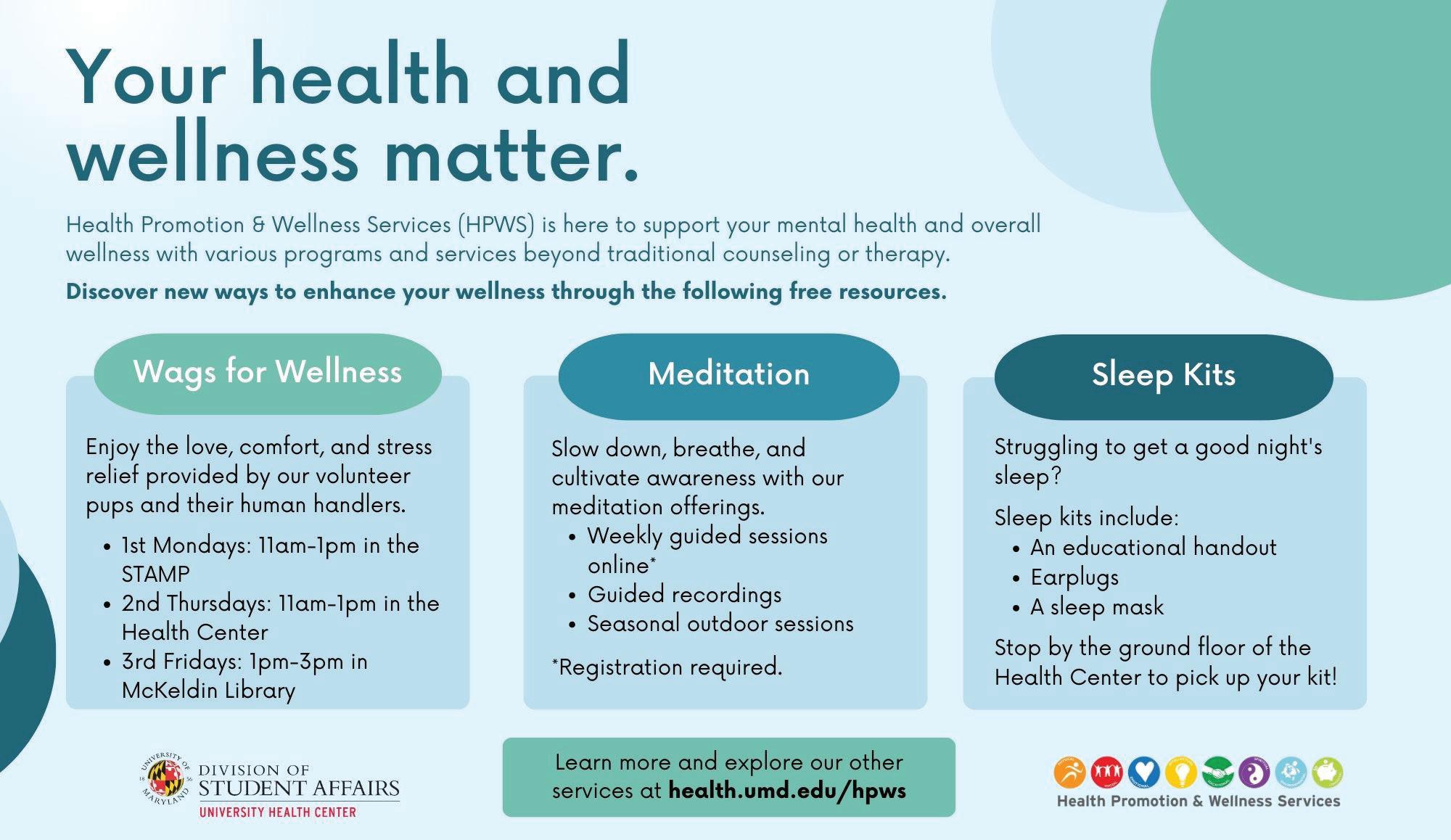

Continuation of “Finance, management among 10 UMD majors with significant enrollment increases since 2012”:
Technological advancements such as artificial intelligence have been a driving factor for significant enrollment increases in five other majors within the engineering school and the computer, mathematical and natural sciences college, according to several faculty members at this university.
Samuel Graham, Jr., the engineering school’s dean, added that as students look for opportunities in space exploration, robotics and autonomy, they turn to fields such as aerospace, mechanical and computer engineering, which are all among the 10 majors that have seen the largest enrollment increases since 2012.
“Artificial intelligence, advances in space exploration, and the electrification of energy systems for state-of-the-art transportation are all examples of breakthroughs driving our society and economy — technologies designed by engineers,” Graham said in a written statement.
Stylish. Convenient. Eco-Friendly.
Cambria College Park seamlessly blends warmth and comfort with stylish, modern accommodations. Within a short walking distance of the University of Maryland, this LEED-certified hotel is the ideal location when visiting the area. It’s also the perfect place to host business meetings and special events.
ROOM AMENITIES FOR A COMFORTABLE STAY
- Bluetooth bathroom mirror
- Mini refrigerator, microwave and Keurig machine
- Desk with ergonomic chair, USB and power outlets
- Complimentary Wi-Fi
FEATURES TO MAKE YOUR STAY MORE ENJOYABLE
- Primetime Restaurant – steaks, chops and seafood – coming in 2024
- 24-hour business center
- Garage parking with EV charging stations
- Dog-friendly
Christopher Cadou, an aerospace engineering professor, said the increased national conversation around space travel and new job prospects at companies such as NASA and SpaceX, has led more students to pursue aerospace engineering.
“Before I started here, it was almost impossible for our graduates to get a job at NASA,” Cadou said. “Now students actually see an opportunity to work in that field — that really exciting field. In my mind, that’s probably why you have more students being attracted to space and you can certainly see in our program now.”
Donald Yeung, the associate chair of the electrical and computer engineering undergraduate education department, said that the development of artificial intelligence has also contributed to more students studying computer engineering.
Yeung said that computing “permeates
majors, such as computer science, have incentivized students to pursue these fields.
Since 2012, computer science majors have seen a 128 percent increase in enrollment as of fall 2022, according to an analysis by The Diamondback.
In a statement to The Diamondback, the university’s computer, mathematical and natural sciences college said that career prospects are “promising for computer science majors.” A 2022 graduation survey from this university’s career center reported that 98 percent of computer science graduates at this university were placed with a range of “notable employers” with a median starting salary of $100,000.
In an interview with The Diamondback, university president Darryll Pines said this university is studying these trends in enrollment and working to ensure every department has su cient resources.

8321 Baltimore Avenue College Park, MD 20740 301.595.2600
CambriaCollegePark.com

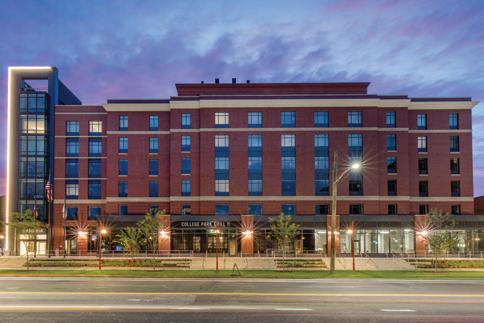
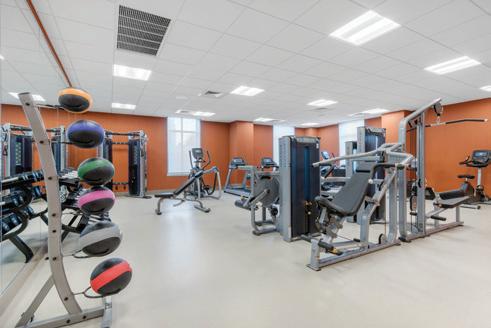
1. You can see the Washington Monument from the top of SECU Stadium.
2. UMD has SIX libraries on campus.
3. There are also six di erent Testudo statues around campus.
4. More than 100 couples get married in the chapel on campus every year.
5. There’s a spot on campus that is supposedly cursed — if you step on the Point of Failure, you won’t graduate in four years.
6. UMD researchers made a computer that can beat Jeopardy! winner Ken Jennings.
7. UMD alumni have won all parts of the EGOT: an Emmy, Grammy, Oscar and Tony.
8. People leave o erings to the Testudo statue in front of McKeldin Library for good luck on their finals. One time, things got out of hand and Testudo caught on fire.
9. Some of National Treasure: Book of Secrets was shot on McKeldin Mall, and part of St. Elmo’s Fire was filmed on Fraternity Row.
10. Part of the music video for Hootie and the Blowfish’s song “Only Wanna Be With You” was shot at the Reckord Armory.
11. UMD has its own golf course.
12. UMD also has its own farm! It’s featured a lot of cool stu over the years, like a living cow with a hole in it.
13. Queen Elizabeth II of England attended her first American football game at UMD.
14. McKeldin Mall is considered the largest collegiate mall in the country!
15. The Testudo statues on campus are based on an actual Diamondback Terrapin, whose taxidermied body is in the University Archives.
16. The Maryland men’s basketball team won the 2002 National Championship, and the women’s basketball team won the national title in 2006.
17. Morrill Hall is the only academic building that survived the 1912 Great Fire.
This article is part of The Diamondback’s 2020 Orientation Guide. Some information and resources have been updated to reflect current dates and events.

It’s unlikely many ears turned toward a University of Maryland classroom on Oct. 11, 1948, when WMUC’s first broadcast crackled to life. The station’s first broadcast lasted only three days due to poor transmission, but began a time-honored student tradition that’s celebrating its 75th anniversary this month.
From a speech department classroom to their third-floor studio at South Campus Dining Hall — with a brief stretch in a renovated shower stall in between — the storied station has adapted to changing times, remaining an essential part of the university’s campus culture.
Over the past couple of decades, independent college radio stations have faced unprecedented challenges, largely due to the expansion of digital music streaming platforms. Throughout the 21st century, a growing number of stations have sold their airwave licenses to national conglomerates, often local NPR a liates.
But WMUC has continued its growth. Former WMUC General Manager Madeline Redding oversaw the switch from 88.1 FM to 90.5 FM in 2021 which boosted the threatened station’s limited broadcast range.
Aidan Appelson, a senior biology major, is the station’s current general manager. According to Appelson, WMUC’s post-pandemic return came with its own set of unforeseen obstacles.
“A lot of our history, as far as I know, got erased during COVID,” Appelson said. “When I started my freshman year, [WMUC] was just a website, so there wasn’t really any community aspect to that.”
By Adam Hudacek I Tabloid editor
In the years since the pandemic, Appelson, along with Program Director Molly Szymanski, has worked to build back WMUC’s station culture. These e orts have included homecoming, prom, bake sales and September’s WMUC Fest music festival.
These events allowed the station to rebound. The number of DJ applicants each semester since the university’s return to in-person has exploded. This fall saw 121 aspiring jockeys vie for a time slot, compared to 44 in fall 2020 — an increase of 175%.
John Davis, a curator at the Michelle Smith Performing Arts Library and a former DJ at WMUC, understands many students’ pull toward the station. Davis joined WMUC in the spring of 1995, where he led his own show, took over Third Rail Radio from founder and housemate Eric Speck and met Mollie, the WMUC sta member who would become his wife.
Davis’ interest in punk and indie rock led him to WMUC’s DJ booth, where the station’s freeform radio format allowed him to explore little-known and underground artists. Freeform, which allows DJs to create unique shows outside of the Top 40 format, has been instrumental in WMUC’s longevity, Davis said.
“[Students] were going there and then it was like a canvas for them to be themselves,” Davis said. “That engenders a lot of loyalty and love for a place when, here’s a place where you’re encouraged to just be yourself and let your taste be heard.”
Some of those ‘90s up-and-comers recorded within WMUC’s music room. Laura Schnitker, an alumni DJ at WMUC and lecturer in the school of music, has led the charge to
save those invaluable pieces of station history.
Since 2011, Schnitker has archived and saved more than 1,500 reels, tapes and discs containing decades of radio memories. Playlists, memorabilia and exclusive recordings were scanned, digitized and organized for future generations of music lovers and station fanatics.
The discovery that sparked Schnitker’s project was a 1971 recording of Don McLean’s “American Pie,” recorded at WMUC before the song’s release. It featured an extra verse buried within the station’s storage.
Schnitker’s work now lives inside the university’s special collections archive, available to anyone looking to explore WMUC’s past.
This fall will see new DJs enter the station’s hallowed halls, their voices ready to join the chorus of WMUC creatives past and present. Wampapedia will mix Wikipedia deep dives with associated music, Bender Haze will shine a spotlight on female and LGBTQ+ artists, while Bits and Pieces will give listeners a chance to pick the tunes.
Fresh ideas and new takes are ensuring that even as the station nears its ninth decade on-air, it will continue to give listeners a reason to tune in. For Appelson, they represent the very reason he joined the station years ago.
“I think it can really just be summarized to uncompromising creativity,” Appelson said. “I take so much pride in having a part to play and making the community we have today.”
With graduation on the horizon, Appelson is excited to come back after the next 25 years for the 100th anniversary.
“Hopefully, they can hear us in Baltimore by then,” he said.

By Katherine Mahoney I Diversionsreporter
Shop Made opened its first Maryland brickand-mortar store this week in the College Park City Hall.
The opening marks the arrival of the Shop Made company’s 10th franchise and second in Maryland. Shop Made established its first location in Washington, D.C., more than five years ago and later opened its first Maryland location inside the Colada Shop in Cabin John.
Inside this newest location, the Maryland community runs deep. From T-shirts, decor and jewelry down to the beer, wine, cider and co ee, everything sold is created in Maryland. Even the decorations in the shop, such as bathroom wallpaper and furniture, are made in the area. During its opening weekend, Shop Made in Maryland hosted a three-day grand opening event for the community.
Shop Made co-founder Stacey Price said the project began in 2017 as an “economic development experiment.” She wanted to explore what it would look like to create a hyperlocal business space focused on the Washington, D.C., region.
“Would we be able to scale businesses? Would we be able to build community and
would we be able to change consumer behavior?” Price said. “The answer to all three questions was ‘yes.’”
The College Park location is the first store many of the 120 featured artists have the opportunity to sell in. For Betsy Martin, the storefront helps smaller artists, many of whom have never sold their products in a retail space before, “kick start” their career.
“It’s a really incredible thing that Stacey and her team have done for the whole DMV area, for Virginia, D.C. and now Maryland,” said Martin, whose design business NotJane is featured at Shop Made in Maryland.
Each quarter, the store will rotate their selection. Current artists in the space will have their works on display alongside new, potential student artists.
While University of Maryland students and community members can shop local products in the College Park store, Shop Made will also o er various activities. Guests will have the opportunity to grow their creativity and community through participating in classes such as wine and watercolors, tufting workshops, wreath making and more.
Price said Shop Made is also planning to have weekly outdoor markets in the spring and student-centered markets to support small creators at this university.
Senior criminology and criminal justice major Addison Lucas said having a new Shop Made location so close to campus helps “unite” the community through local art and artists.
“It showcases local art from vendors, so students that are in those kinds of majors can see that they can make it,” Lucas, who is a barista at Shop Made in Maryland, said. “I feel like that’s very inspiring.”
Martin emphasized that the newest Shop Made location is a “fantastic” way to promote more artists in the local community.
“It’s going to be a really excellent addition to the neighborhood. I feel like it’s going to be a great creative hub,” Martin said. “I think Shop Made Maryland, the Shop Made brands in general, do a really great job of showcasing all the creativity in the area.”
Diversions reporter Sophia Slaughenhoupt contributed to this story.

A Shop made location in College Park on Dec. 7, 2023. (Sophia Slaughenhoupt/the diamondback)
By Sumaya Abdel-Motagaly I Sta writer
University of Maryland students are praising this university’s first-ever halal food station located in the 251 North Dining Hall.
The new station, which opened in August, serves halal food that is certified by the Islamic Services of America, a member of the World Halal Food Council. The food is prepared and cooked on surfaces dedicated for halal foods — separate from equipment used for non-halal foods.
The addition is part of a proposal submitted in March by the Halal Food Standards Alliance of America, a non-profit organization that certifies halal food, and the Muslim Student Association to increase options for Muslim students at dining halls.
Halal — “permissible” in Arabic — refers to foods that are lawful to eat for Muslims. In order for meat to be considered “halal,” the animal must be slaughtered according to Islamic guidelines. This includes, but is not limited to, mentioning God’s name when killing the animal in a swift and painless manner, according to the Islamic Services of America.
Foods containing pork and the meat of carnivores are also forbidden in order to be considered “halal.”
Currently, all three dining halls at this university serve “halal-friendly” foods— meaning the food was prepared with halal ingredients, according to Dining Services spokesperson Bart Hipple.
But “halal-friendly” foods are prepared on equipment that was once used for non-halal foods, though the equipment was cleaned and sterilized, Hipple added.
According to Hipple, the new station in 251 North prepares halal meat separate from equipment used to prepare non-halal options.
“We want all of our resident students to be able to eat confidently and comfortably,” Hipple said.
Before she knew about the new halal
food station, freshman journalism and public policy major Farah Rahman said she only consumed vegetarian foods at dining halls. Rahman, who only eats halal food, said the addition of the new station made her “really happy” due to the more diverse o erings for Muslim students.
“[Eating halal] is important to me because it’s one of the values of Islam,” Rahman said. “It’s something that I wanted to continue in college. I didn’t want to give that up just because there weren’t options.”
Like Rahman, sophomore environmental science and technology major Jishan Chowdhury said he had no expectations for Dining Services to incorporate halal meat options.
Chowdhury said that without the dining halls’ halal options, he considered only consuming vegan options, but noted he is “thankful” for the additions.
Currently, the new station only serves chicken — supplied by Midamar Corporation, a global halal food brand and supply chain company.
According to Hipple, Midamar chicken costs three times more than other chicken served in dining halls.
The university is working on a contract with another supplier because Midamar is unable
to keep up with the university’s usage, Hipple said.
“Halal meats are more expensive, because to keep the product halal requires additional and dedicated equipment,” Hipple said.
The new options also garnered support from members of this university’s MSA.
Junior information science and operations management and business analytics major Adam Ghannoum, who is MSA’s president, emphasized that he is grateful for the new halal options.
“It means a lot that the university is able to give us that option of halal,” Ghannoum said. “When it comes to meat, [Muslims] have to eat something that is slaughtered the halal way.”


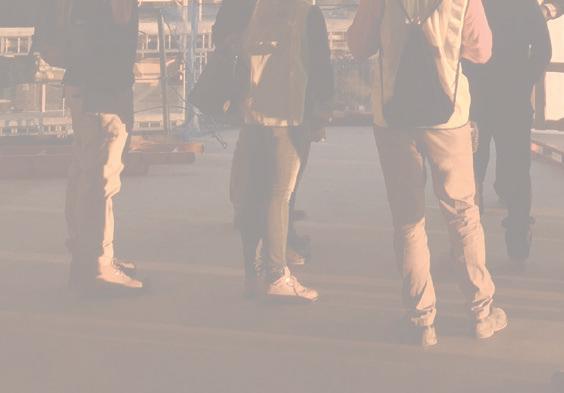


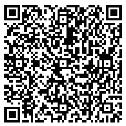
The University of Maryland SGA is working with Dining Services to potentially increase kosher food options on campus.
The most accessible place to get kosher food at this university is Maryland Hillel, which o ers its own dining plan. But some students feel the hours and location — near South Campus — are often inaccessible or inconvenient, so members of the Student Government Association are advocating for more on-campus options for those who keep kosher.
The undergraduate student population at this university is about 19 percent Jewish, according to Hillel. Among other restrictions, most kosher guidelines do not allow for meat and dairy to be consumed or prepared together, which prevents some Jewish students from eating foods at campus dining halls.
Eliav Hamburger, the speaker of the legislature, said SGA members are advocating for a kosher kitchen in a campus dining hall.
“That is the only way to really and truly solve the problem of Jewish students not being able to live on campus,” Hamburger, a junior computer engineering major, said.
Dining Services spokesperson Bart Hipple said the department is tentatively looking for ways to incorporate more kosher options on campus, including potentially turning the former shop attached to 251 North into a kosher kitchen.
By Lillian Glaros I Sta writer
Students could use disposable silverware to eat food from the kosher kitchen in 251 North if the plan is put in place, Hipple said.
Dining Services is also looking at the possibility of taking over operations of the Hillel dining room and incorporating it as a fourth campus dining hall, according to Hipple.
He added that Dining Services is also working with Hillel to provide dining dollars at a discount to those who have a Hillel dining plan. The department is also looking to add more packaged and labeled kosher and halal options to on-campus shops.
Jewish members of the SGA brought up the need for more kosher options after struggling to access the options at Hillel, they said.
Meirav Solomon, the freshmen connection representative for the SGA, keeps kosher. The freshman history and public policy major said when she had classes in the evening during the freshmen connection program, she found it hard to make it to Hillel’s dining hall, which closes at 7:30 p.m.
Shuli Frenkel, the parliamentarian for the SGA, also said the location and hours of existing kosher options can be inconvenient.
“I wouldn’t be able to make my lunch because by the time I was able to walk all the way over, it would be put away, it would be done, and then there wasn’t food until 5:30,” the sophomore
criminology and criminal justice said. “And then my option was like a granola bar.”
Frenkel added that the lack of kosher options in dining halls is a barrier that keeps students from participating in social opportunities and food culture at this university, such as karaoke nights at dining halls. They’ve seen people on YikYak talk about the music and culture at Yahentamitsi Dining Hall compared to South Campus Dining Hall.
“I’ve never experienced any of those things and I don’t even really know what that means,” Frenkel said.
Many students who keep kosher have to move o campus to abide by kosher guidelines, Frenkel added.
A lack of kosher food on North Campus also makes it di cult for students who observe kosher to participate in living-learning programs that require them to live in particular dorms and participate in a campus dining plan, Hamburger said.
Cost is a barrier to adding more kosher food on campus and in dining halls because kosher food can cost more than non-kosher food, Hipple said.
“We’re trying to figure out how to be as inclusive as we possibly can be, but we also have to make sure that the specific dietary needs of one group don’t overtake costs and the operation for the majority of the group,” Hipple said.
